| |||||||
| Search Forums |
| Advanced Search |
| Go to Page... |
 |
| Search this Thread |  42,671 views |
| | #16 |
| BHPian Join Date: Feb 2007 Location: Delhi / Jaipur
Posts: 112
Thanked: 264 Times
| Bhawani Mandap and around With no one around to explain where next to go, I exited from a different point from where I had entered, walking via a school premises and to the second spot on the checklist – Bhawani Mandap. Contrary to my assumption, the ‘mandap’ was not the corrugated tin enclosure underneath which I stood at that time but the temple to Bhawani (below), that has a great following amongst all in Kolhapur and surrounding areas. It is a fascinating façade – two storeys – the first floor (second if you’re ‘murrican), has a balcony with round pillars supporting the roof above. In the centre of the shed hangs a ‘panch-batti’ (five lights).  Rain picked up again and these two ladies were saved from the rain by a good 'Idea'.  The steel roof itself provides a very useful space, in climatic conditions such as these, to just about anyone looking for a shelter. There're semi permanent shops selling items suitable for puja, stray bicycles, shoe stand, a chair for the door guard, and a few motorbikes parked temporarily. Lastly, I saw some village folk resting under the covered area outside the temple, awaiting an audience with the deity. 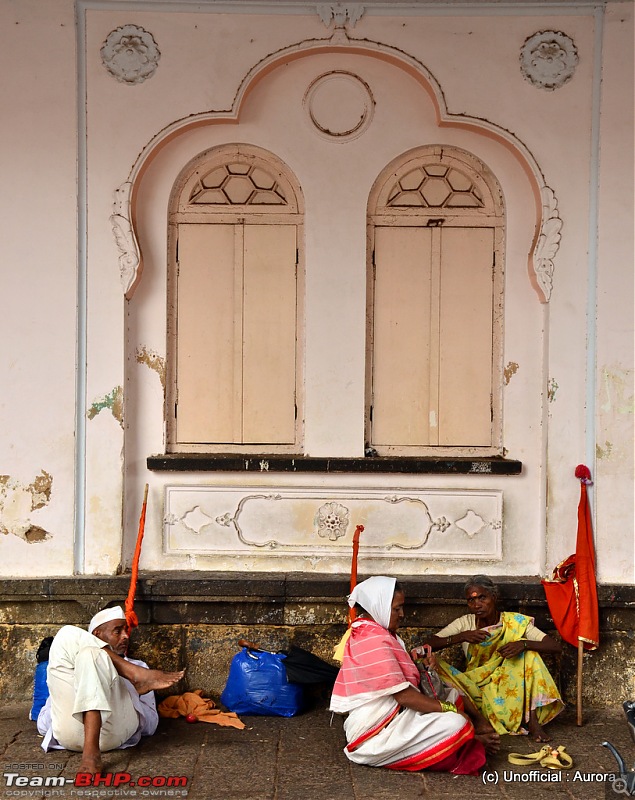 The rain had nearly stopped and looking out towards the main square and the gate beyond it, I noticed that the steel sheet roof was supported by a two level colonnade that was a mirror image of the one on the left, near the temple building itself. 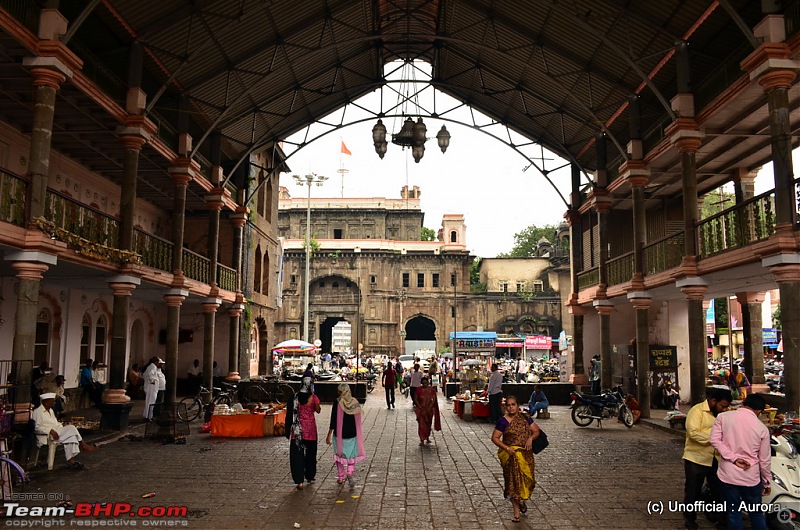 I walked out to the main square (mahalaxmi was to my left now) and a Rajwada gate in front but first, attended to more pressing business – food – on my left were a couple pushkarts and a makeshift shop protected from the elements by blue tarp. 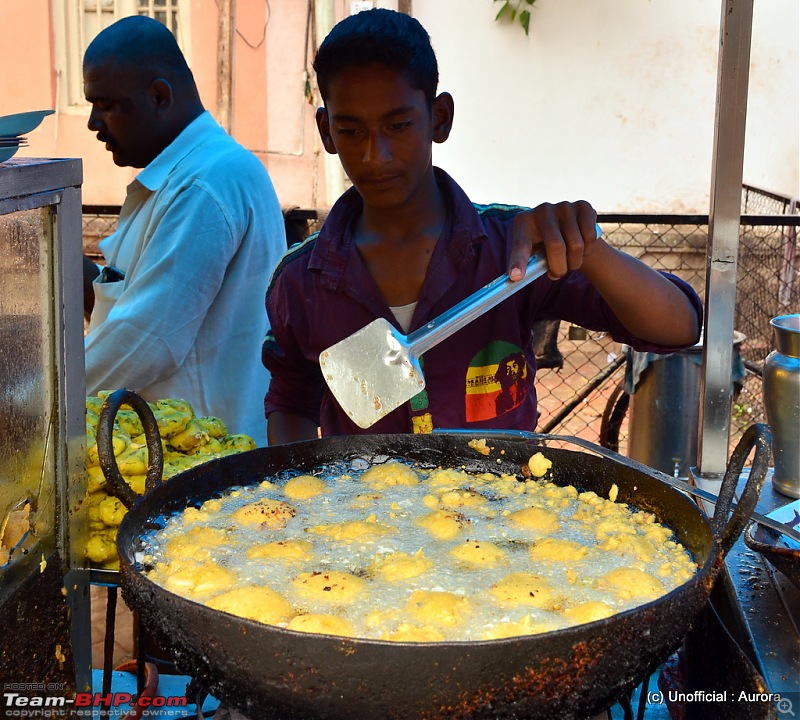 Vada pao das rupaye (vada pao ten rupees) – screamed this scene though it didn’t speak. If you enter the great state of Maharashtra, and don’t eat vada pao, it’s a criminal offense – or ought to be. Gobbled up a few.  The second one was a bit curios – it served what the marathis call ‘appe’ but I knew this dish from the time spent in Tamil Nadu – Kuzhi Paniyaram. I chit chatted with the owner but left it at that. On the left is a Dabheli (Gujarati attempt at a burger, almost).  Diffused lighting made it a tough task to photograph the superb statue of K D Jadhav – India’s first Olympic medalist in any sport. Jadhav won the bronze for wrestling at Helsinki in 1952.  His connection with Kolhapur is unique – Jadhav was facilitated by his college and all the wrestling Gymkhanas of Kohlapur. The principal of Shahaji Law College, Kolhapur, Prof Dabholkar mortgaged his own house to fund Jadhav’s participation in the Olympics. Jadhav had not forgotten this favour and on his return, he organized a wrestling competition in which he took part himself. He won several bouts in these competitions and handed over the prize money to his professor and persuaded him to use the money to buy back his house. Even tougher it was to get a good shot of the Rajwada gate, thanks to the traffic whooshing by.  Once past this, on the right was the spectacular building of Rajaram college – built in 1880 by the then Maharaja of Kolhapur. At present, the building houses a school but it is fascinating to look at as it’s not built in a Maratha style – but in Rajput style.  Inside the perimeter stands a two storey building that rises a bit abruptly. Colonnaded verandas are topped by graceful Rajput domes, chhatris grace the corners and windows are decorated with jaali work. There's even a balcony shaped like the zenana's - for the ladies to watch the activities below unobserved. On the whole, the building looks more like a Rajput palace than a school in Kolhapur. 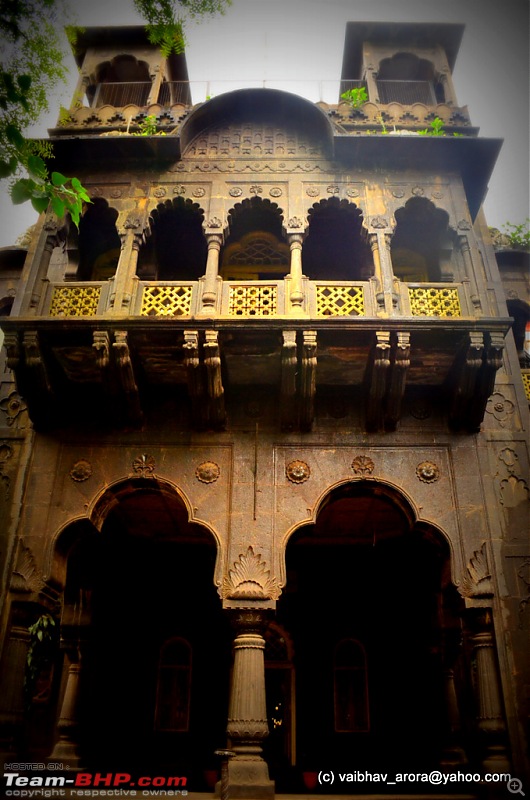 Some structures, such as this fountain, push the envelope even further and made me think if the owner of the building didn't change his mind halfway about the intended usage - from palace to school.  If the stone color and the lush green vegetation didn’t belie this building’s daccani placement, one could be forgiven for thinking that one wasn’t standing in southern Mahratta territory, but somewhere in the Rajputana.  This for example is the area where the principal’s office is – on the first floor is a pavilion through which, had this been a palace, the womenfolk would have looked out at the world below – I do not know what purpose it serves now. Marathas are very proud of their culture and emphasize the usage of their language all over Maharashtra – in Kolhapur, it was impossible to find a sign in Hindi, a few were in English though, but everywhere they were foremost in Marathi. I was amused to find Abe Lincoln’s famous ‘Letter to Headmaster’ painted on a board at this school in Kolhapur – in Marathi, of course.  Back on the road, spotted these enticing Guavas, carved by the cart owner and blessed by Indra – the god of rains. 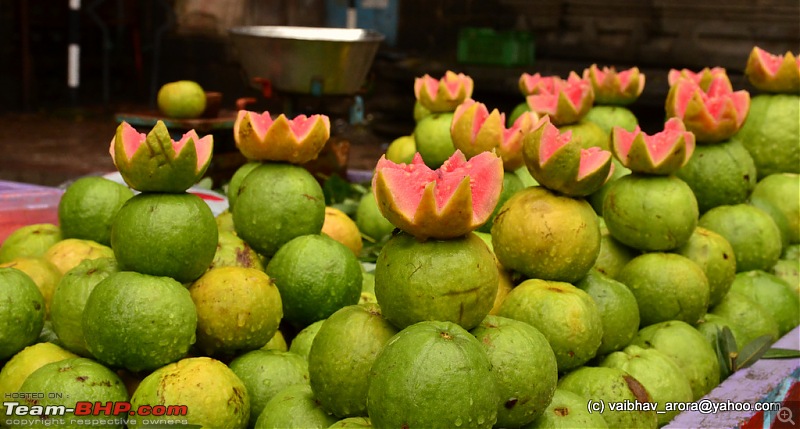 Once more, feeling peckish, I walked into a yet another random multi-purpose milk parlor – these seem to grow everywhere in Kolhapur (must be the fertile soil and copious rainfall). I ordered a Sabudana Khichadi (sago couscous).  It was exceptionally well done and served with some sweet yogurt based chutney. I ate all of it hurriedly as we don’t get this back in Rajasthan. Truth be told, we get little more than sand for breakfast and gravel for dinner – water on alternate days. Last edited by vaibhav_a_a : 12th December 2015 at 10:19. |
| |  (6)
Thanks (6)
Thanks
 |
| The following 6 BHPians Thank vaibhav_a_a for this useful post: | adc, blackwasp, JoseVijay, mallumowgli, pankaj_sachdeva, rav11stars |
| |
| | #17 |
| Senior - BHPian | Re: A Monsoon Solo: Kolhapur, Ganpatipule, Ratnagiri & beyond Good to see Kolhapur from a different perspective. Been there many times, yet feels like seeing something new. Thanks vaibhav_a_a for this ! |
| |  (1)
Thanks (1)
Thanks
 |
| The following BHPian Thanks blackwasp for this useful post: | vaibhav_a_a |
| | #18 |
| BHPian Join Date: Feb 2007 Location: Delhi / Jaipur
Posts: 112
Thanked: 264 Times
| This enchanted land of faeries and daemons A kindly man outside the shop, when asked about the new palace, suggested that I drop in at Town hall museum first and then visited the new palace museum. I was told it was no more than a half kilometer but I suspect it was much longer – my foot was hurting quite a bit by the time I got to the place. On the longish walk I observed yet another ‘take’ on the ‘no parking outside the gate’ sign. [hey, it doesn’t say anything about parking inside the gate].  After some struggle with directions, reached the Town hall museum. But of course the staff wanted the place to get closed at the earliest – they had to have lunch. Photography was banned and they had CCTV cameras all over the place. For some reason I could not understand but was not in a position to argue over – shoes must be left outside the main door. This is a museum, not a temple, I wanted to protest, but I thought I should get done with it as quickly as possible. The museum's collection is quite limited but it's worth dropping in if you're in the neighborhood. There's a collection of a dozen busts of various kings of the British Empire and their queens - I distinctly recall George V. Made of marble, these busts are about a century old and well done. Apart from this, there were very few jaw dropping exhibits - but for an admission price of rupees three, one can't complain. There were two good exhibits that were worth taking a photo of – one was a map showing Kolhapur’s connection with the outside world over centuries (going as far back in time as the Periplus of the Erythrean sea) and the other were the official court portraits of the various kings over the centuries – they were large oils, up to five feet tall hung up on the wall, in the two story high atrium space as one enters. I was done in about fifteen minutes. I then spent time in the expansive gardens of the Town Hall. The gardens are nice, though I didn’t understand how a ‘star fruit’ common all over the country and called ‘kamrakh’ merits the ‘protected’ status – perhaps because this particular tree was imported from America? (Better known as ‘amreeka’). Here's a little photo collage to give you an idea - 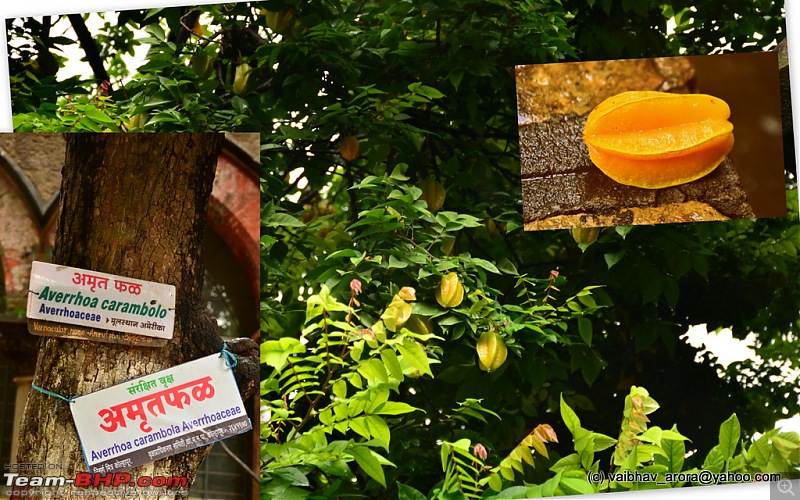 The building of town hall is over a hundred years old, looks the part, and is set in sylvan surroundings. The sloping corrugated sheet roof is painted a duckweed green, tall arches support the beams upon which it rests - but the coconut trees surrounding it are taller still.  Everything was further helped by the rain – there was nary a speck of dust, just sparkling emerald all over. Here’s the artificial pond cum fountain out front – idyllic.  And this it the front view of the main building – a hundred years old , architect-ed by the British army major ''Mad'' Charles Mant. A symmetric triptych of pointed arches form the facade of the ground floor portico. On either side of the building, towers rise, topped by pyramidal roofs. The portico has been closed from one side to form the space used for dispensing tickets and the shoe stand.  In the Sahyadris, Ghats and Konkan, the soil so fertile that all manners of plants grow together easily. Further on, they are very healthy and in some cases, over-sized – like they’re fed steroids regularly. Hailing from a desert state, Rajasthan, I’m always amazed when I see trees as tall as this one – the contrast between the size of the car and the tree is so pronounced. A look at the hanging vines makes one wonder if Tarzan is going to enter the frame any minute (got some water on the lens, apologies)  Gobsmacked at the size of the leaves – this same plant when grown in our garden in Jaipur produces leaves half this size, but then we don't feed him very well.  On the back of the building was this small garden – a cycas in the centre, surrounded by green lotus leaves – green grass all around, fringed by green mango, coconut and other trees and some green seasonals. Did I mention the word 'green'?  Nearer the main gate stands this Malaysian tropical rubber tree that has spread its evil roots too far and wide for anyone to escape.  Towards the back is this Victorian wrought iron pavilion under which some locals were enjoying a picnic. The palms are taller still. The pavilion should have been around for about a hundred years.  The locals, maybe since the 60s – they never moved once throughout my photo expedition.  After this visual overdose of chlorophyll, it was time to leave. But, before I left, I captured the steady, watchful gaze of the man who influenced the shaping of this land, its people and their collective conscience so much – Shivaji.  [Is it just me or does anyone else also think that there’s a distinct resemblance with Milind Gunaji, the Marathi filmstar? Or is it supposed to be the other way round?] Last edited by vaibhav_a_a : 14th December 2015 at 07:33. |
| |  (7)
Thanks (7)
Thanks
 |
| The following 7 BHPians Thank vaibhav_a_a for this useful post: | adc, Gannu_1, JoseVijay, Mahesh Prasad, mallumowgli, pankaj_sachdeva, rav11stars |
| | #19 |
| BHPian Join Date: Feb 2007 Location: Delhi / Jaipur
Posts: 112
Thanked: 264 Times
| New Palace and close of day's play New Palace and close of day's play Out the gate, hailed an auto to drop me to new palace – it cost about Rs 50/- and fifteen minutes. The tickets for the palace cost Rs 20/- for Indians and 75/- for foreigners, but that includes a cup of coffee. Interesting combination.  The entrance is watched over by a great cannon, at that time unable to defend itself from schoolchildren who insisted on riding it – nemmind if it’s a national treasure and all that. 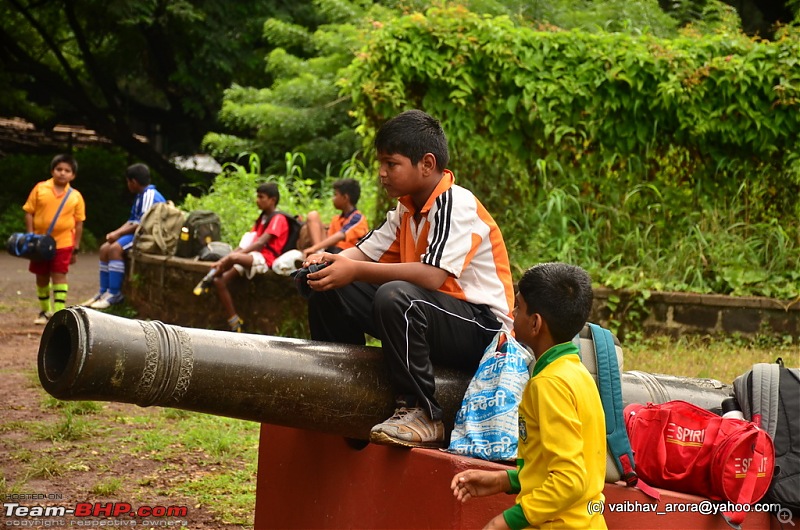 A little later, I was able to appreciate the cannon from closer quarters – it was used on a sailing ship, and was dated 1639 – that much is evident from the photograph. Google told me later that it belonged to the Dutch East India Company (VOC) and was built in Rotterdam. It’s a beautiful bronze piece and though exposed to the elements was quite shiny.  I then entered the premises of the ‘New’ Palace – built about a hundred years ago. British Army Major Charles Mant (sometimes referred to as ‘mad’ Charles Mant) was the architect. The building, though described to be built in Indo-Sarcenic, appears a curios amalgamation of styles many, and a tad tough to isolate.  For example, there’s a chhatri atop the clock tower that's not large enough to cover over it like an umbrella – something a true Rajput chhatri would do. Also, the small arches underneath are trefoil - more commonly seen in churches.  I would have taken more photos of the building from its side but the watchman whistled to indicate I was to go no further – apparently a part is still used by the royal family as residence. Closer up though, some of the carving appeared done well. The whistle grew louder and I turned back, crossed the front lawns and to the other side.  From extreme right of the front side, it was apparent that the building is not symmetric – there’s a section that juts out. Interestingly this section is topped by small domes that are more reminiscent of Mughal domes seen in mosques across the vast swathe of the indo-gangetic plain. By the time I got this photograph, the watchman had caught up with me. 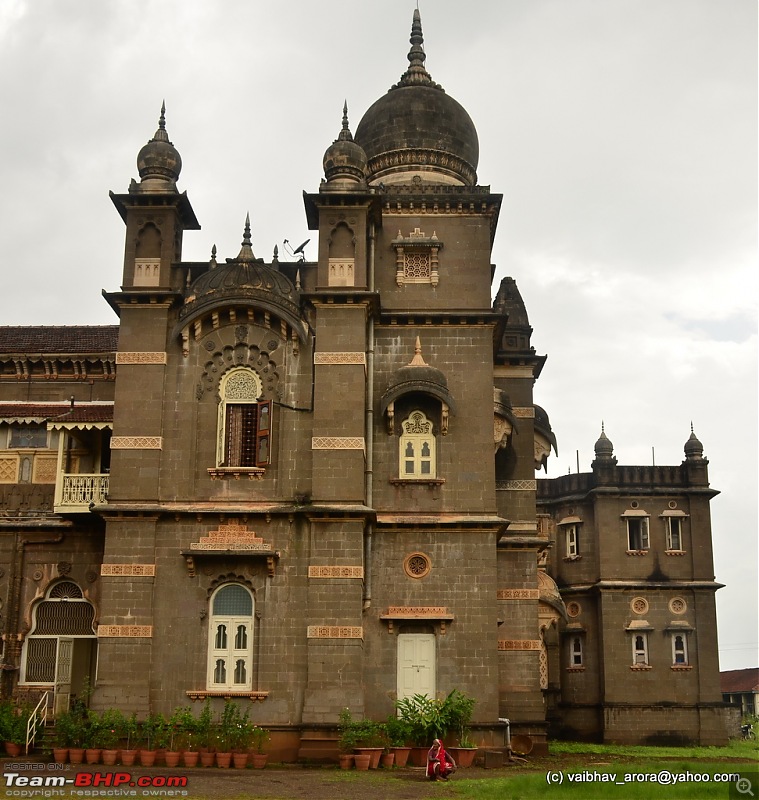 He may have wondered why I was smiling. Well, the building reminded me of a book ‘Punjabi Baroque and other memories of architecture’ that talks about how, in India, there exists a world of architecture completely dictated by personal idiosyncracies, driven by men who measured their self-worth by the money they made and projected this measure outward in the shape of homes they built. The architect was merely a conduit. At the entrance, the rigmarole of taking shoes off was repeated. Along with that, another stern warning against photography. Right foot was in pain now and the bare floors, cold to touch were not helping. I walked in and was immediately stuck by how dusty the place looked. Now, as a self-confessed history buff and museum lover, I’ve never said a word against the most ill-kempt of museums anywhere I’ve been – and that includes the semi locked room atop Kalinjar fort and the parts of Tanjore palace under renovation – but about new palace, am sorry to say, it requires better maintenance as well as labeling effort. There were several rooms that house furniture, how the maharajahs lived, but the worst (which from their standpoint were probably the best?) were the ones displaying stuffed animals the kings of Kolhapur had hunted down over several decades. I counted eleven full size tigers, at least one bear, a rhinoceros and heads of deer too numerous to count. What’s worse isn’t just the fact that these are on proud display, but the terrible state these are in. A fair bit of the collection truly shows its age, and I could smell the slow decay. This doesn’t end here – even the durbar hall that should have been a wonder to behold looked damp, unpolished and dusty. I could immediately contrast it with the one I had seen in Gwalior – several notches higher. To make matters worse, several college girls were using their mobile phones and clicking #darbarselfies. Oh, and almost all the fun stuff, such as old photographs are labelled only in Marathi. No wonder foreigners have to be compensated with a cuppa joe. As I left, I gave the chowkidaar a piece of my mind and complained loudly against the violation of the ban against photography inside. I then quietly slipped away before he had the time to create trouble for the girls while I was on the scene. All in all, the palace is well worth a visit, but more for the building and less for what's show cased inside. Exhausted, I got into the first auto whose wallah agreed to ferry me back to the hotel I was staying at. I was quite tired by then and needed some shut eye. The autowallah had other plans – he insisted that we stop at a place of his choice to see ‘a wonder of Kolhapur’. I was quite unsure about that and thought I was getting into a variant of the carpet seller scam. However, this apprehension was quickly dispelled when we got off the auto in front of a house that appeared semi locked. I thought we’d go back now but our man led me down a narrow gallery on the side of the house. It seemed rather hush hush but I followed him anyways. The gallery was no longer than fifteen feet and didn’t belie what stood at the other end – it was this –  I was told that this is a Himalayan fig tree and was brought here by a sage. I’m sure he named someone but I can’t remember now. It was simply such a surprise that I was quite happy that I had believed him enough to come here. After this trailer, the deal for tomorrow’s show was finalized. Ramchandra would take me in his auto to Panhala fort and Jyotiba dongar and drop me at a suitable point from where I could go onwards to Ratnagiri. That way, I would save about 20 kms or so. I had another vada pao before retiring to my room – this pao is little more than bread, baked fresh every morning and sliced. Back in the room, I slept soundly.  Around half past six in the evening, I woke up and realized that I hadn’t gone to Rankala lake or Phadtare and I wont get a chance tomorrow! Rushed outside, it was drizzling but not much. I asked a man near the hotel the way to get to Rankala lake and through the course of the conversation, he explained he was the manager of Mahalaxmi temple. He was terribly sorry that I couldn’t get to visit the temple in the morning from the inside. So sorry in fact that he gave me a ride on his scooty to the temple, and asked me to wait a bit near the gate while he went inside to check how crowded it was. The light around was very pretty, with sellers setting up shop in the middle of this lane leading to the temple.  In the time that he was gone, I eyed some of the tantalizing sour delicacies on sale. In the photograph below from bottom to top are large indian gooseberries (amla) sold raw, smaller variant of the same fruit sold with masala, the larger ones sliced and salted and slices of raw mango with salt and chilli. Of course I bought as much as I could handle that evening.  Mr Manager came back by then and profusely apologized that it was indeed very crowded and if I wanted to click photographs inside, someone else might complain. Instead, he gave me a DVD that talks about the temple and has some mythological stories. It was quite incredible that he did all that. He also insisted that I come back in the morning and get as many photos as I felt like. Anyways, I found myself a shop near the temple selling missal, sat down and ate the stuff. After that experience, I can tell you that I’m not a missal man. As I left that area, looked up to find Rajwada gate lit and looked quite nice under the lights as did Bhawani mandap.  Before I went back to the hotel and to my room, I had one last item on the agenda – despite it having been a full day, I walked through the busy market looking for an acceptable copy of Gowri (gawri) (?) , it was something that had caught my attention at Sansaar Bhandar in the morning. Among the myriad thalis, kadhais and spoons, these little doll like votive objects command attention. Turned out they are made of copper, and are in fact two pieces, one vessel at the bottom making up the body and a smaller, inverted vessel making the head. It’s considered a form of goddess and is filled with rice when the prayers commence. I told them that I’d probably stop by later (before I left Kolhapur) and purchase one. Now, I reckoned I won’t get there before the shop closed and I was better off looking for them here, in the market area. 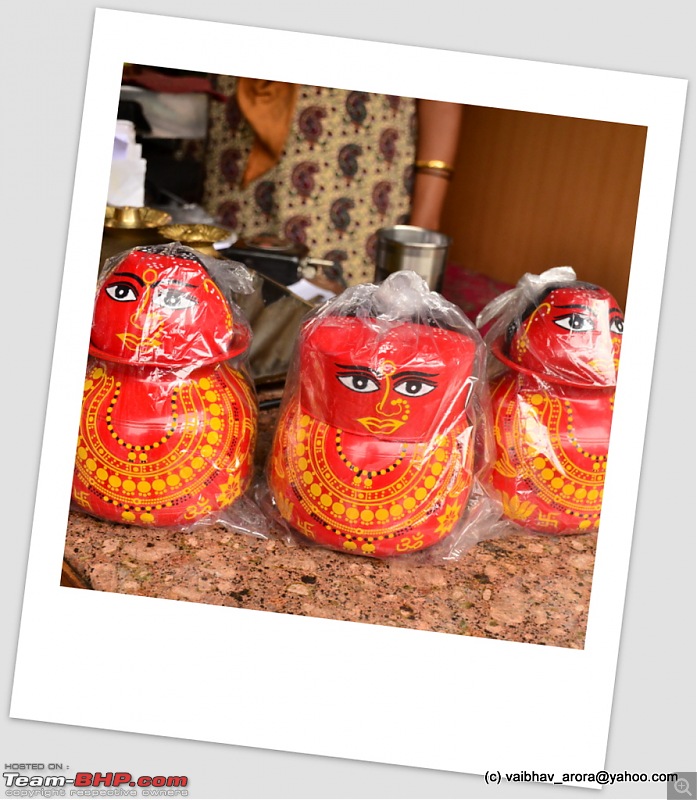 After struggling for nearly a half hour, with piece after piece I inspected, turned out to be created using stickers and not hand painted, I gave up and took an auto back to the hotel. Surprisingly, Sansaar bhandar was still open – and of course he was happy to sell me a piece. I had had a long and tiring day at Kolhapur, but one full of very pleasant surprises. Last edited by vaibhav_a_a : 15th December 2015 at 12:35. |
| |  (6)
Thanks (6)
Thanks
 |
| The following 6 BHPians Thank vaibhav_a_a for this useful post: | Gannu_1, mallumowgli, pankaj_sachdeva, procrj, rav11stars, vinit.merchant |
| | #20 |
| BHPian Join Date: Dec 2015 Location: Mumbai
Posts: 43
Thanked: 20 Times
| Re: A Monsoon Solo: Kolhapur, Ganpatipule, Ratnagiri & beyond Good one vaibhav_a_a. I had been to Kolhapur some time back & it was nice to refresh memory with extraordinary snaps of ordinary/routine aspects of life which are often ignored. It also proves that just having a good camera is not enough, you need to have a good eye. Eagerly awaiting remaining part of your journey. |
| |  (1)
Thanks (1)
Thanks
 |
| The following BHPian Thanks Inner Voice for this useful post: | vaibhav_a_a |
| | #21 |
| BHPian Join Date: Feb 2007 Location: Delhi / Jaipur
Posts: 112
Thanked: 264 Times
| Up the hill At eight in the morning, I was sitting in this road side shack with a small plate of soft, flaky poha. The man sitting opposite me was a local, a medical rep at that. Jackpot, I thought and proceeded with my volley of questions. The man proved to be steadier than Rahul Dravid on a turning pitch and stalled every single question with a gentle, almost there, smile and ‘I’m not so sure but I think it is very much possible’. Technically perfect shots, but completely useless for the given situation.  Around 9, Ram showed up with his Auto and we left shortly thereafter. A steady drizzle built up by then and I couldn’t capture a troupe of men and women dressed gaily, that passed us by carrying a small palanquin of sorts. Ram, a perceptive fellow, explained that what I just witnessed was a ceremony wherein local people bring in the water of the panchganga river during rainy season, the day after ambabai’s temple opens and offer that water at the temple of Renukadevi at Temblai. The two goddesses are sisters but apparently do not get along. At half past nine we were at vantage point from where to view Panchganga ghats. This view point is on the main road as one goes towards Panhala and there’s a little watchtower (burj) constructed here as well as a little garden. It was all nicely washed naturally at that time.  These Ghats appear medieval, though I was told they are ancient, and were lined with several temples.  A few larger ones were across a small road parallel to the stairs that descent into the water, but some appeared completely submerged – they had good company – a buffalo and its attendant.  The river, on that overcast rainy day, had a particularly sinister reddish brown colour, the sort that would hide anything or anyone – just long enough to avoid detection till they could no longer be saved. It was a troubling thought and I didn’t want to stay there much longer.  After some photographs, we left and continued onwards and passed over yet another structure named after Shivaji – in this case, it was a bridge. Turns out this wasn't the first Shivaji, but a subsequent ruler, who got along splendidly with the British (yesterday at the New Palace museum, there were several photographs in which members of the British royalty was seen along with the then king of kolhapur - it was always an ''allied state'') 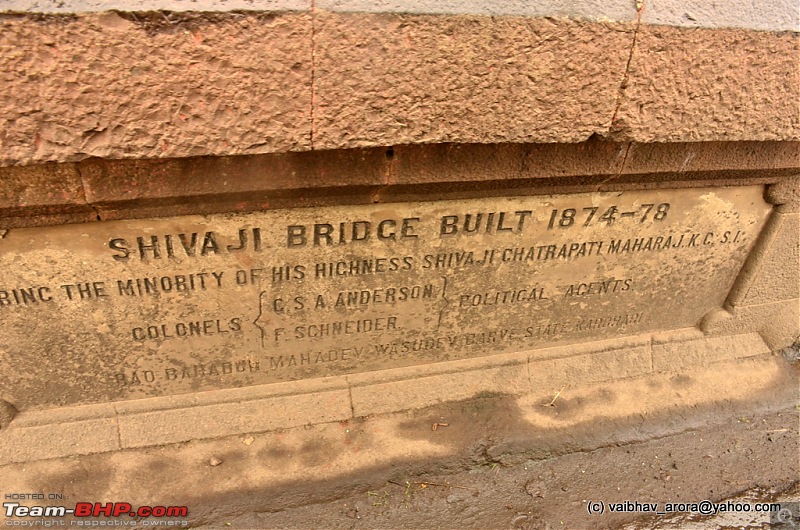 Soon after this, we were speeding along on a two lane, smooth road towards the fort – that lies approximately twenty kilometres from the town of Kolhapur. Two wheeler traffic was quite high but no jams, etc.  The weather was cool and comfortable and we also passed under trees (a variety of ficus) whose roots had been formed into arches by the vehicles passing underneath and hitting against them regularly. So uniform was the shape that they appeared trimmed, but Ram insisted that they weren't. 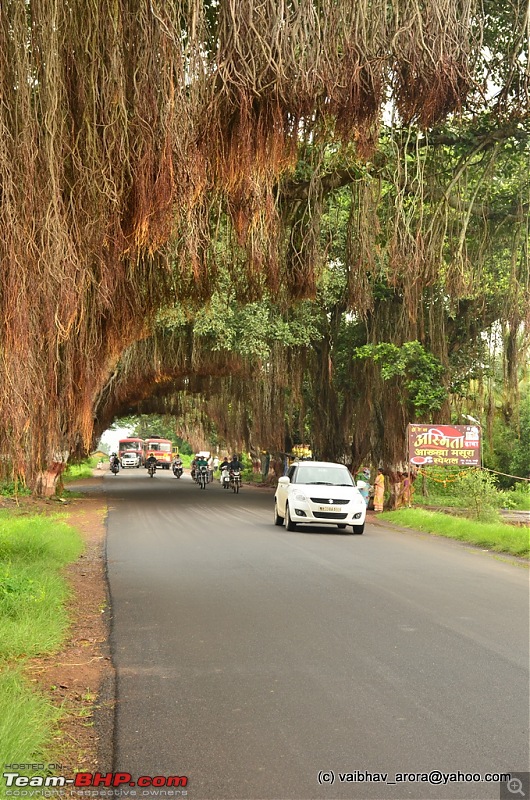 I hoped for the remaining journey to be quiet, even uneventful, just so i could take advantage of the superb breeze and reflect upon life, or sleep, whichever happened first. Ram had other plans. Innocuous questions such as ‘where you’re from’ soon transmogrified to more serious stuff 'shaadi?' and then he was elaborating upon his name, his father’s insistence on absolute honesty and other lessons in moral science class I had conveniently slept through back in school. By ten Am, this auto was climbing the winding road towards the hills atop which the fort of Panhala lay. The steady drizzle had stopped but also left every leaf washed.  At a spot a few kilometres short of our destination (Ram wouldn’t tell me how many), the forest was no longer with us and instead there was a view extending several kilometres – even on this heavily overcast monsoon day. 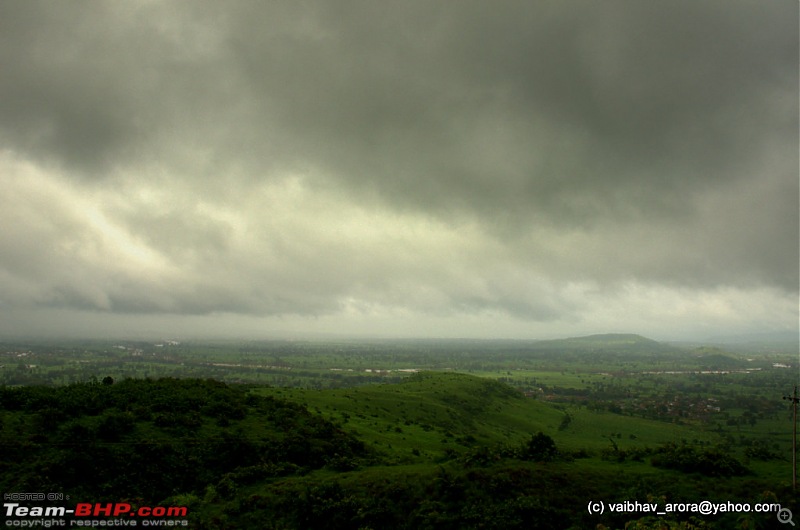 I will let a few photographs do the talking – A little rivulet winds its way/ Water obstacle on this colossal golfing green/ Where imaginary giants play.  Saranyu desires to cover Prithvi / A cotton quilt can scarce contain a body living/ Overnight maybe but just about, The very first rays of Surya, Cause the tips to stretch out.  The clouds did not rain, thankfully / Behind unsuspecting landforms they gather around/ a little light upon this little temple’s foreground.  Shades of green/ Light through the watery tent above/ creating hues previously unseen.  As I was about to get into the auto to ride onwards, noticed that one cloud had come so close to earth – Saranyu was meeting Prithvi, neither complained, a scene picture perfect.  A half kilometre before our first stop, Jyotiba dongar, there was an artificial pond, a talab if you will, covered in glorious hill station style mist. All around it was a perfect cover of green – trees and grass- and the only missing piece in the photograph was Zeenat Aman, the Bollywood star, in a white saree coming out of the water.  I looked hard but there was no trace of her, instead there was the auto driver grinning at me through his fat moustache. Such is life, sigh. I tried tracking a Brahminy kite here and failed as did a couple who arrived after me. So we pushed on to Jyotiba Dongar – or Joytiba’s temple. Last edited by vaibhav_a_a : 17th December 2015 at 15:47. |
| |  (7)
Thanks (7)
Thanks
 |
| The following 7 BHPians Thank vaibhav_a_a for this useful post: | adc, Gannu_1, Mahesh Prasad, mallumowgli, procrj, rav11stars, vinit.merchant |
| | #22 |
| BHPian Join Date: Feb 2007 Location: Delhi / Jaipur
Posts: 112
Thanked: 264 Times
| Jyotiba Dongar Shortly thereafter, we were at the temple. I left my shoes and socks in the auto itself and walked over to the temple, passing under a high arched gate and to the main structure that had some corrugated steel awning out front. I first went to the right, attempted to chit chat with a priest there if it was possible to climb atop the arcaded veranda. Hard luck as they close the stairs during rainy season. With little option to photograph a good panoramic shot of the temple, I settled for this one below – it shows the main temple and two smaller temples, each topped with a lovely shikhara.  What’s truly jaw dropping is the size of the lamp towers (deepasthamba) – tallest I’ve seen on this trip and perhaps anywhere. An adult man standing next to them looked so tiny.  I then went for a customary circumambulation of the temple premises. No further than ten meters from the gate, under the arcaded veranda along with boundary wall was a reminder that the medieval marathas left no stone unturned when it came to usage of suitable locations as defence set ups.  This wheeled canon was in much better repair than the one in mahalaxmi temple and the end point of this veranda was open in front and looked down upon the valley below. I suppose the overall height of the perimeter wall, the fortified gates and the presence of this cannon lends credence to the assumption that in times of dire need, a small contingent could retreat to this premises and live on for a bit, even if the plains had descended into turbulent times. Further on, turned a bit to the right and caught these two rural Marathi devotees through my shutter, especially since their saree was tied so differently from the way urban folks do. Around their middle toes they had solid bands of silver as ornaments, their gums red with betel leaf – little things one never gets to see in our daily lives.  Opposite where the ladies were, a man was smashing a coconut on the ground – he was dressed as most rural Maharashtrians dress – a white collared shirt along with white trousers and a white multipurpose scarf.  To my left I saw something I have never seen before – a largish statue of kamadhenu – the mythical wish fulfilling cow. The scale is perfect – a sort of 7:6 – just a bit larger than life to make it notable, but not double the real life that’d make it intimidating. The placement of such a statue in this temple is significant – Maharashtrians (marathas specifically) were pastoralists and agriculturists – even some of the royalty (the holkars for example) moved profession from being cowherds to rulers. A kamadhenu fits right in. 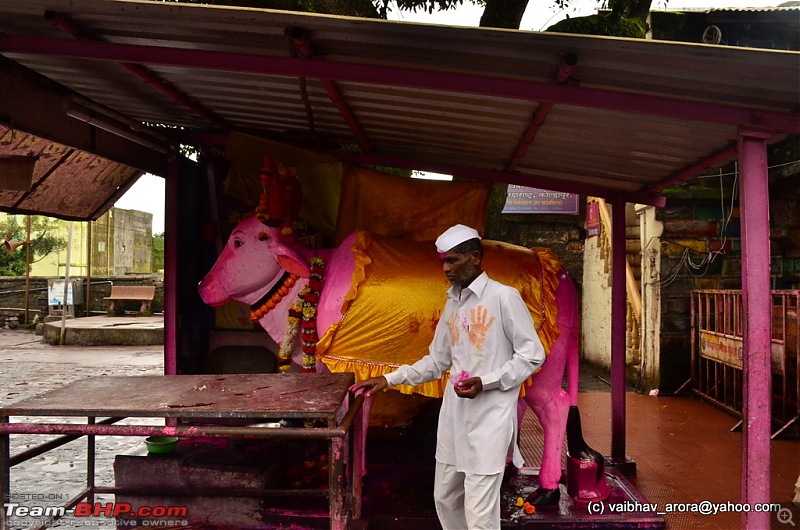 Moving ahead, I noticed that all around me, the ground was covered with something darkish pink, more magenta than red. It was the color of a specific gulaal (colored talc powder) that is considered as a suitable offering for Jyotiba. In these monsoonal days, the reddishness was a bit more pronounced and the liquid color provided the black stone a surreal look.  I went towards the opening where the ladies had come out from – that part was the subsidiary temple as it turned out. It was here that I found the boy priest with the matching magenta shawl - that you've already seen in the teaser post – after a convoluted barricade was negotiated. The entrance to this portion was a triptych of arches – fascinating and even more fort like. Devotees with no thoughts other than a desire to see the deity, touched the door frame and the threshold and offered some gulaal as they entered, unmindful of the color staining their clothes. They were truly in a state of bliss. I wished I could be so carefree.  Inside, the board reads ‘Shree Jotirlinga Prasann’ – Or may the divine light be pleased (this is the form of Shiva). Under the magnificient arch, a smaller door lead to the temple proper – what set it apart was the metallic encrustation it was subjected to all along the frame and the sill – brass I suspect.  No ordinary frame, this, the threshold was high, the frames on either side had statues of horses and winged attendants and a garland of lotuses greeted the visitor. The shine looked golden – a bit higher than what brass is capable of, could very well be thanks to the yellow metal. The magenta of the gulaal contrasted handsomely with the door's golden hue.  I stepped in, and after a moment’s hesitation, asked the priest and was overjoyed at being allowed to photograph the deity itself – the lights were not conducive to photography though. 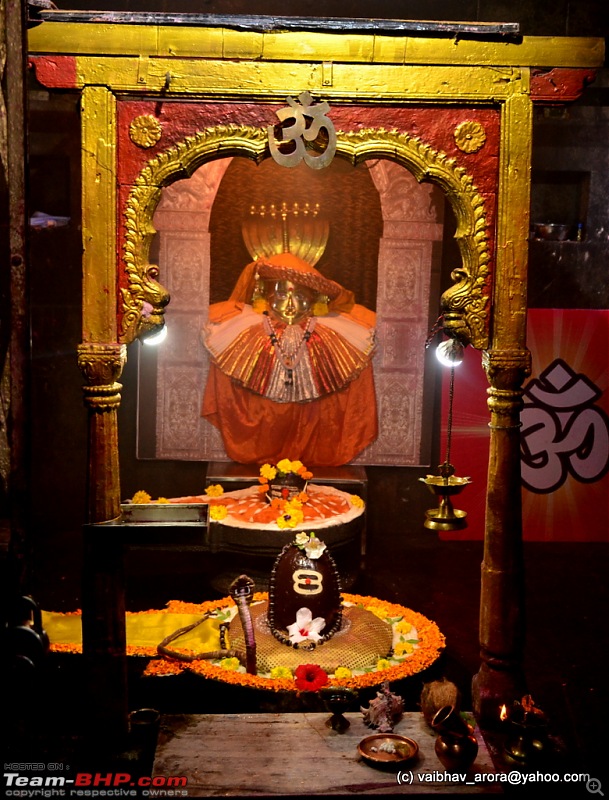 I heard a man playing a drum, first slowly and then to a certain beat. I did a small video, which may or may not give you an idea of the beat – but take my word for it, dear reader, that at that time, the small chamber was resonating better than the best subwoofer. {Note: The video is in full HD, so you should change the resolution once it opens in youtube to better experience this amazing temple  } }I was back outside and nearly 180 degrees from where I had entered, there was another large gate, this one protected on one side by a tall peepul tree and on the other by a lovely elephant statue. Beyond the elephant statue was another ‘tin-shed’ with a very definite purpose – it was the space where priests sat and smashed a coconut on behalf of the devotee and offered a small prayer if they were so engaged. Very streamlined. [I was later told that I was very lucky to find the temple this empty as on important occasions, the queues are up to two hours long!]  The backside of the temple holds another statue of Jyotiba – a mirror image if you will – for those days when the main deity is inaccessible for any reason. People queue up here too. The porch in front of this little statue had so much gulaal splashed onto it, it appeared like ‘holi’ season to me! 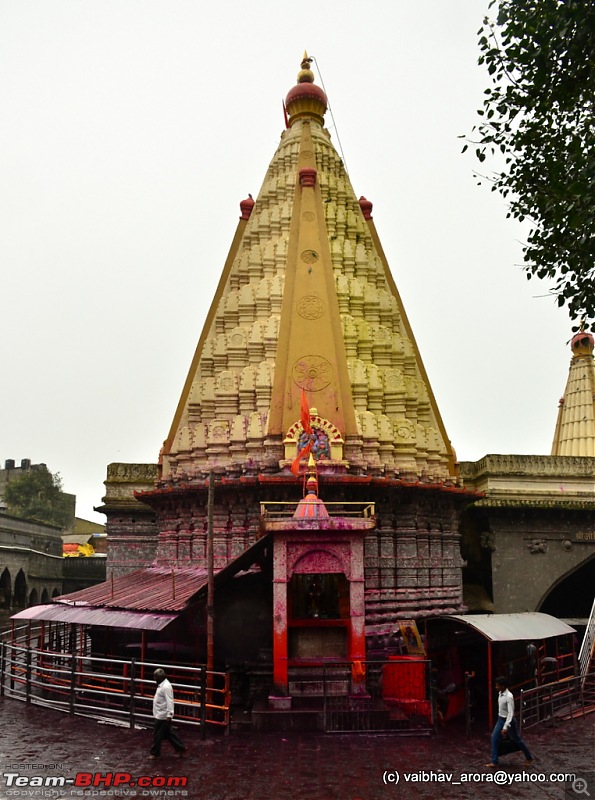 Looked heavenwards again and thought how much like inverted ice cream cones these spires look – One butterscotch for me, please. After the blasphemous thoughts had passed, I was back where I started from - a corrugated sheet roof covered front of the main temple and without further delay, I decided to go inside the main temple. Last edited by vaibhav_a_a : 19th December 2015 at 10:22. |
| |  (3)
Thanks (3)
Thanks
 |
| The following 3 BHPians Thank vaibhav_a_a for this useful post: | adc, mallumowgli, rav11stars |
| | #23 |
| BHPian Join Date: Feb 2007 Location: Delhi / Jaipur
Posts: 112
Thanked: 264 Times
| Inside Jyotiba Dongar temple kolhapur I went up a short flight of stairs, to a raised pedestal, under a stone veranda that serves as protection from the elements. It had a wall on the left, a door at the far end and was open on the right side. I walked past the people sitting on my left as it was quite dark inside and I didn’t realize who they were. It was only when I turned back that I saw that these three were priests with their backs to the wall, available to provide blessings to anyone who sought. On this dull rainy day there were precious few people.  The priests, surprisingly, didn’t ask for anything – they didn’t ask who I was, where I came from, or anything more personal – and I clearly do not look Maharashtrian. To top that I was carrying a large DSLR camera with a long lens and flash attached on top, camera bag on the shoulder. I smiled at them and they smiled back. We chit chatted a bit then and they were just happy, a bit shy even about the entire conversation. The color of ‘gulaal’ (colored powder) was stunning though and the marigolds juxtaposed against it so perfectly. It was strewn over the yagya kund (place where fire is burnt to offer homage to the gods) and instead of samidha (wood used for ceremonial burning), there were flower petals inside. Something was off – a rounded rock on the right extreme – this part turned out to be the representation of the asura (demon) that jyotiba had slayed. This is said to be the eye of Ratnasur and the locals call is ‘Dantai Dola’.  One of the three priests brought some nariyal (coconut) from inside the temple.  After this veranda, through yet another brass plated gorgeous door, I was inside the main chamber, a sort of a prayer hall that overlooked the garbha griha (Sanctum sanctorum). I think I expected a more cumbersome entrance given the place’s importance, so it was a pleasant surprise. Further, imagine my joy when the priest actually smiled at me when I asked if I could take a few photos inside. We quickly had an understanding that it was OK to photograph anything including the principal idol as long as I don’t publish that photograph (close up of jyotiba), and I have to keep my word. The room I was in was square in plan, not too high a roof and arches on all four sides. Two of these sides led to smaller chambers that housed the principal deity and his consort. I had read that the temple is medieval but I assure you that these inner chambers are anything but – they are positively ancient. On either side of the enclosure of Jotiba, the principal deity were his attendant gods – Ganesha on one side – smeared so lovingly and so often with the magenta gulaal by devotees and sindoor (vermillion) by the priests that the color of the base stone is scarcely seen. On the other side is Hanuman (referred to as Maruti in Maharashtra).  This apparent anomaly of mixing the attendant gods of Vaishnavite and Shaivite sects is well explained when one does a bit of research. Turns out that Jyotiba is considered to be an incarnation of the holy trinity and one of the sapta-rishis (Jamadagni) and essentially is therefore, a form of Dattatreya. Dattatreya temples are few and far between and held especially sacred by the ‘nath’ sampradaya – the one headquartered in Gorakhpur. The drum player was now here - 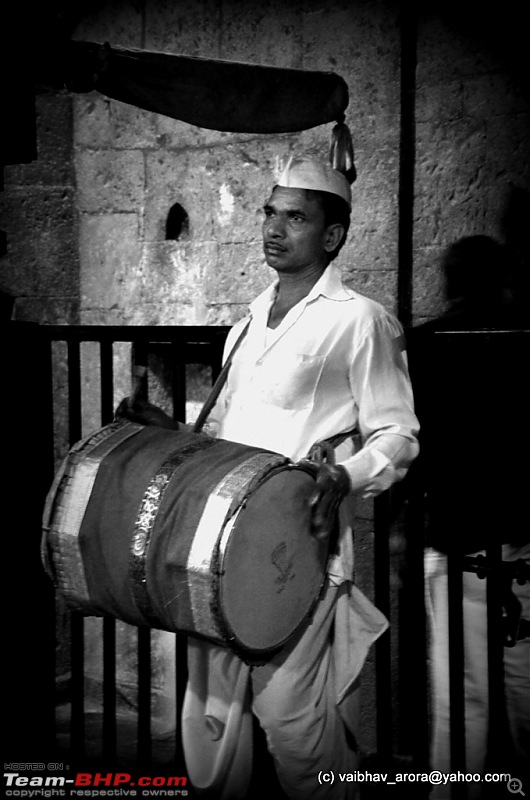 On the right of the principal statue is a smaller chamber that houses the idol of his consort. It was locked and out of bounds for photography anyways. This is what is installed atop the chamber, a brass ganesha -  This photo, from a slightly longer distance is OK to share and shows the innermost chamber with Jyotiba installed. His idol, of black stone, is displayed with a ‘’torana’’ behind of real silver. If the flowers appear fresh and the clothes appear new – it is because they are. On the left, a pillar is seen – it’s plated with brass. Jyotiba is a warrior god – he slayed Raktabhoj Ratnasur, who ruled this hill top called Wadi Ratnagiri before the god arrived. He is thus shown with his horse on his right, a sword on his left and in a pose that’s typically martial. 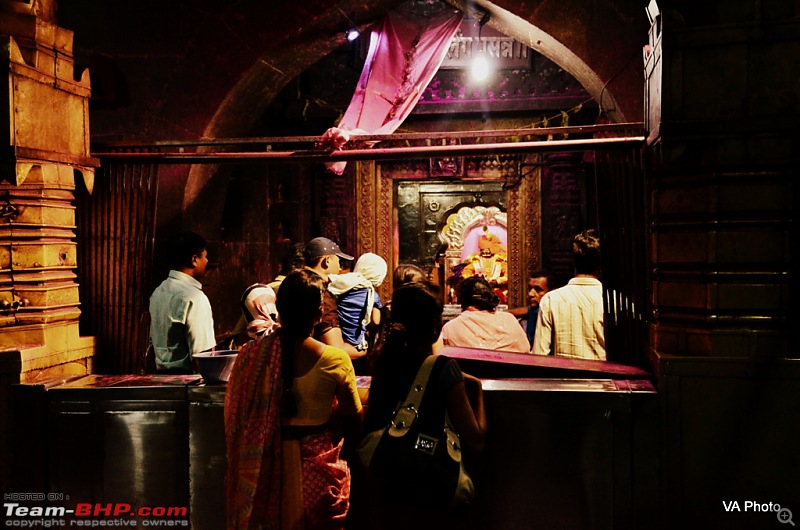 This is the palanquin in which Jyotiba leaves his sanctuary for important processions. It hung from the ceiling, somewhat ignored – despite a silver leaf coating that is superbly designed - can you see the little peacocks on each end?  What a contrast from yesterday when I was told clearly by the ice queen on the gate that I couldn’t photograph inside mahalaxmi. So relieved and satisfied I was by this turn of events that I wanted to leave immediately and thus started in the general direction of Ram and his chariot. However that was not to be as Indra intervened and raindrops larger than marbles descended from the heavens. Sought sanctuary under the gate and got a shot of the inside-  And of the pathway leading to the temple - lined on either side with the gulaal much used in the temple and other material required for offering prayers - fresh flowers and sweets.  After this, it was hobble hop to the transport device. Ram was at his hospitable best – a bit too much - asking if he should get me some tea – I should have been alarmed if I were paying him too much but I was just really happy at that time and I didn’t notice the red flag. |
| |  (3)
Thanks (3)
Thanks
 |
| The following 3 BHPians Thank vaibhav_a_a for this useful post: | adc, mallumowgli, rav11stars |
| | #24 |
| BHPian Join Date: Feb 2007 Location: Delhi / Jaipur
Posts: 112
Thanked: 264 Times
| Serpent's Lair Nearly half past eleven, no longer raining but beautifully misty still, in the auto we ride, to the fort called Panhala. As a self-confessed history buff, that fort had been on the list for a while – I have been to forts that are considered representative for their type – Golconda for deccan, Chittorgarh for mewar, Jaisalmer for maru, Delhi and Agra for Mughal, Kalinjar for bundelkhand, Uperkot for Gujarat but never to anywhere substantial in Maharashtra. At the same time, I’ve never been very impressed by the forts outside of Rajasthan, the lone exception being Gwalior. It perhaps has to do with the fairy tale look of the forts in the state – Mehrangarh rises steeply from a rock edifice, Amer looks lovely under lights and absolutely nothing compares to the scale of Chittor. Further they are in general in a better state of repair than their deccan counterparts. Given the above mind-set, Panhala certainly turned out to be a fort most unusual – but its charms are not apparent on first glance. It requires some sense of the sequence of events that have transpired here, on premises and a few others that led to cementing this fort’s place in annals of Maratha, and late medieval Indian history. Panhala’s name is indelibly written in the biography of the greatest Maratha king of all – Chhatrapati Shivaji maharaj. Discounting the forts he spent time in during his childhood, this is the only one that he is reported to have spent more than 500 days in – and that should tell you something about its importance. After all, he did have another 300 forts to choose from – spread over a sweeping landmass – from the western fort of Colaba, all the way down south to Gingee, in present day Tamil Nadu. The statue on the primary drive way leading to the major buildings of the fort is of Bajiprabhu Deshpande – the Maratha commander of Shivaji’s forces who sacrificed his own life at the battle of Pavankhind, about forty kilometres from this spot – so that his king may live and re-build his kingdom. Three and a half centuries after his sacrifice, many local people remember the event like it was yesterday – the garland around this statue was of flowers no more than a day old.  From here, we went through a longish drive way, on either side of which were commercial establishments ranging from small shops to larger, upcoming ‘resorts’ – this is a living fort – though not in the same sense as say, Jaisalmer. The first recognizable building we reached was Andhar Bawdi – literally the dark well – a three level structure built by the adil shahis of Bijapur to control the water supply into the fort.  It is here that we get the first glimpse of the practical mind-set of the great Maratha – he didn’t build the fort – far from it. He simply used it. And unlike his predecessors in this fort, he also made no attempts to obliterate symbols of the previous occupiers – on top of the bawdi is a Persian inscription.  The bawdi had spaces such as these for soldiers to live on either side of the main open air atrium that led to the water (one such space is seen below). The soldiers could, in the event of a desperate retreat, poison the water supply leaving the fort unlivable.  Another interesting historical remnant talks to the fort’s builders – these inverted lotuses (on the ceiling of the arcade) are from the Shilhara dynasty and belong to the builder of this fort - Raja Bhoj II (distinct from Bhoj of the Parmara dynasty – the founder of Bhopal).  From the ramparts near the structure I was shown another example of the fort’s defenses – large stones that had been thrown down by the soldiers to repel an invading army.  Further the view from here is spectacular – green countryside as far as the eye could see (clichéd, but true in this case, there’s almost no urbanization this side). It doesn’t require much imagination to see what it would have looked like during the times of the great Maratha.  The impact of the repeated lashings by the monsoon could be seen on the fort itself – every inch of rock that yielded a foothold to the plants had been occupied.  The fort takes excellent advantage of the topography of the place as we shall see in ‘our’ next stop, dear reader – the gate called ‘teen darwaza’ (three doors) - a short drive from Andhar Bawdi (also the road in the scene above is leading to the darwaza).  Teen Darwaza is the most recognizable symbol of the fort – notably since the earliest photograph of the fort – from the 1890s shows this structure. As we (my driver and I) went in, I saw on top (previous image) are symbols of the adil shahis – peacocks. They built this part of the gate. As we walked into the corridor, flanked on either side by a high arched and pillar supported roof, I realized how dark it was, even though it was broad daylight outside. Ram showed me something interesting – the construction material included lead – the joints between several stone blocks were scratched already and the black metal was shining through.  The exit to the middle, courtyard of the gate had loops at the top and bottom, from where at some point of time, a door would have been attached.  Once inside the courtyard, it dawned upon me that the darwaza’s simple appearance belies a cunning design. If invading soldiers were able to breach the outermost gate – on the other side of the courtyard, they could not see the other gate immediately (the one we had just passed through) as there is no line of sight. Then, the opposing army hidden in the arcaded veranda surrounding this courtyard had another, very good chance of neutralizing them.  The above photo is from a similar angle as the one in the Wikipedia entry for the fort – the one there was photographed in 1890s.Here's another one from a different angle that shows the arcaded veranda inside which the soldiers used to live and the ''kothi'' on first floor from where they could keep a watch on the inside as well as the outside of the fort-  We also find the two roaring lions around a ganesha – the symbol of the marathas - on the lintel of this gate. Again, the marathas had appropriated the structure and embossed their authority - wonderfully practical.  I was then taken outside the second gate – basically outside the fort – to see the design a bit better. The walls do not rise straight – they are sloping gently – perhaps an 85 degree angle – and there is no mortar used – stones are just placed atop another – too smooth to scale without a rope. 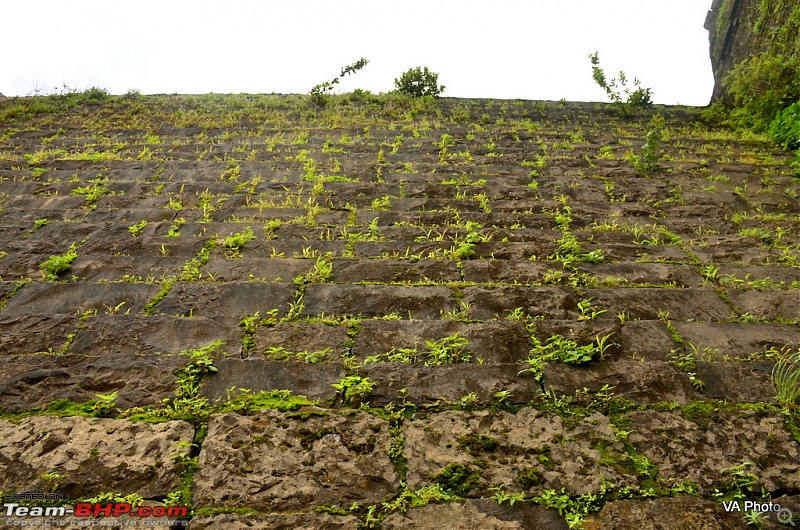 And truly, when I looked back inside the fort, I could only see a wall – that’s what an invader would have seen, after breaching the gate.  I got back inside and feeling quite hungry, wanted lunch. Before I left though, I climbed on top of the gate, using the same stairs that the soldiers would have used about three hundred years back to enter the ''kothi'' (watchtower) and got a good view of the inside courtyard -  So we went to one of the two open ‘breakfast centres’ in the fort – makeshift shops with open facades. One of them was populated by the bunch of miscreants from previous morning – the students.  They looked at me and smiled sheepishly. Their teacher was more genial and came over to shake hands. I asked Ram to join for the lunch as well though he was a bit hesitant initially. I thought it’d be an experience to take his advice for lunch and eat the same food – so I asked what the local speciality was and he recommended ‘Nachani Bhakri with Thecha’. 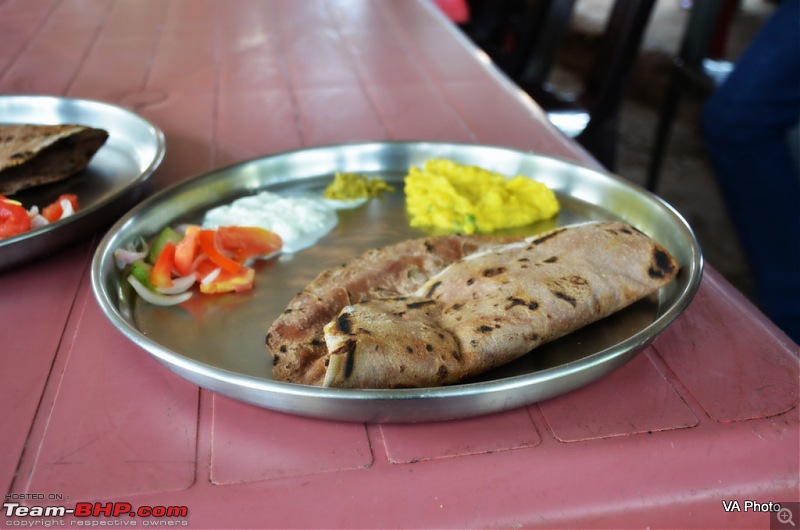 The Bhakri (roti) was oversized and of the grain I know better as Ragi (finger millet). It was served with a dash of very sour curds, a hint of chilli thecha and a wisp of salad. The yellow ‘pithla’ was made of chickpea flour and had a custardy consistency. The combined effect was energizing, thirst inducing but also very filling. My meal cost Rs 60/- but boy was I full. |
| |  (4)
Thanks (4)
Thanks
 |
| The following 4 BHPians Thank vaibhav_a_a for this useful post: | adc, Figopian, raghuvir, rav11stars |
| | #25 |
| BHPian Join Date: Feb 2007 Location: Delhi / Jaipur
Posts: 112
Thanked: 264 Times
| Panhala after lunch After lunch, I felt like doing a whistle-stop tour of anything important and move on to the spot from where i could get the bus to Ratnagiri; as the heat was not conducive to postprandial relaxation. However, my driver cum guide was clear that ''you should visit all the major major spots'' Then he added "Visit properly, you won't enjoy it otherwise’’. Off we were. Ironically, the first stop we visited after lunch was called Ambarkhana (the granary). It is a complex of three buildings called Ganga, Jamuna and Saraswati. Built first by the Shilharas in the twelfth century and then again in the fifteenth by the Adilshahis, the structures dont appear very impressive from the outside. I was told that grains would be poured down from the holes up top and the doors of today were closed. Grain would then come out, as needed, from gaps below the threshold of these doors. Ingenious – though a bit hard to believe. It is said that this granary helped the residents of a fort to withstand a siege for upto six months - such is its capacity. Here’s Ganga’s elevation shot - the gap below the threshold clearly visible. 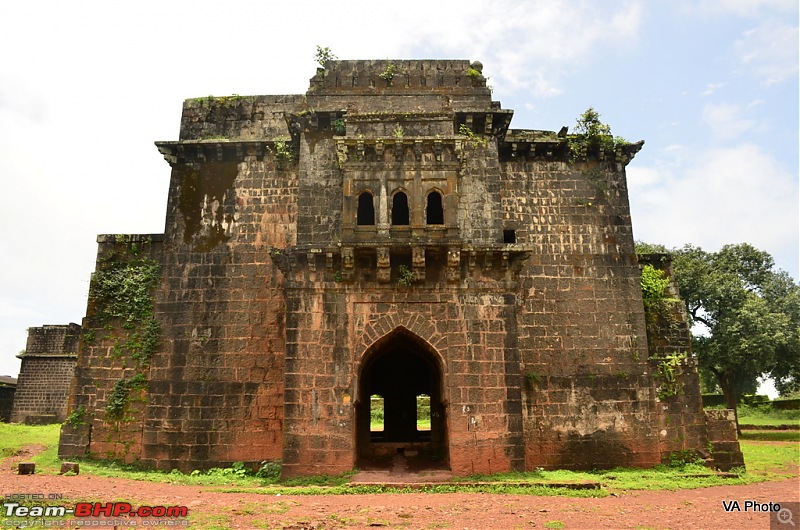 The buildings are set in a largish compound which is a gated, protected complex and also has some dead trees like this one. Black stones, dead trees, empty spaces and a man with a moustache who insisted that we visit every single dark and isolated corner. Perfect.  As I stepped inside, for a few seconds I thought the light was gone or at-least my eye sight was weaker than usual. And then i saw the light coming in from heavens - that proverbial light that was to deliver me to a better place, away from all the worldly pains. I was positive that the meal I was fed a short while back included something 'special'. But then a voice said "Woh hole hai na sahib, usmein se daalte the" (It's from the hole in the roof that they poured grains) Oh, I see.  Looked dead ahead and tried to focus better but couldn’t. I just knew my ''guide's'' nefarious plan. I bet it was here that ''bees saal baad'' the bolly horror flick was shot and now, it will be ''bees saal baad'' (twenty years later) that they'd find my remains. I wanted to call my parents and tell them how much i loved them but it was too late. Ram was reaching into his bag already. I knew what was coming. All this smooth talking, to put the quarry at ease. A gentle build up leading to an isolated spot - and then ....  Ram brought out my water bottle that i had forgotten at the lunch spot. He said ''sahib, aapko shayad pyaas lagi hai; ladkhada rahe hain" (sahib, I think you're thirsty. You're not very steady). I gruffly thanked him, drank some water and handed the bottle back. But I wasn't going to be off my guard so easily. History after all, is written by survivors. We moved onto the third building of the complex, smallest of the lot. It was described to me as a mint, by the man who never lied. Google doesn’t support this but I bought this description as it’s more colourful. Besides the light formed really cute spots on the floor.  We then went out of the granary cum mint complex to see remainder of the fort. Of the various bastions in the fort, many were broken down during battle – most notably by the last occupiers of the fort – the British. One that stands and is of importance is Rajdindi – for it is from here that Shivaji escaped to the fortress of Vishalgad after five month long siege by the invading army led by the Siddi (Abyssinian) Johar. It was an isolated place, again.  I was feeling dehydrated and thought I should turn back but Ram was at his over-hospitable best. Egging me on he said, ‘’Sahib. Please come up. The view is worth it”.I clambered on top, wary of there being no railing or anything to prevent anyone from falling off a hundred feet below or worse, being pushed. Green, fertile fields as far as the eye could see – monsoon paints everything so lush. [easier to hide a body, too]  I bet I saw him smile a bit.Rain picked up once more and I broached the topic of whether we should leave the fort – but Ram suggested we visit at least one major spot he had in mind. Soon we were at the ‘’showpiece’’ spot. When shivaji had a massive disagreement with his son, Sambhaji, the latter threatened to defect to Aurangzeb – the last Mughal emperor. So, shivaji had his son imprisoned temporarily here – at the building called Sajja kothi.This is a two story structure with the upper story containing a small room for observant Muslims who used it to pray – it is unique in that respect (of being a small, closed structure not at a ground floor where ''namaz'' was allowed). Best of all, Sajjakothi's balcony had ample railings to prevent any ''accidental'' falls. 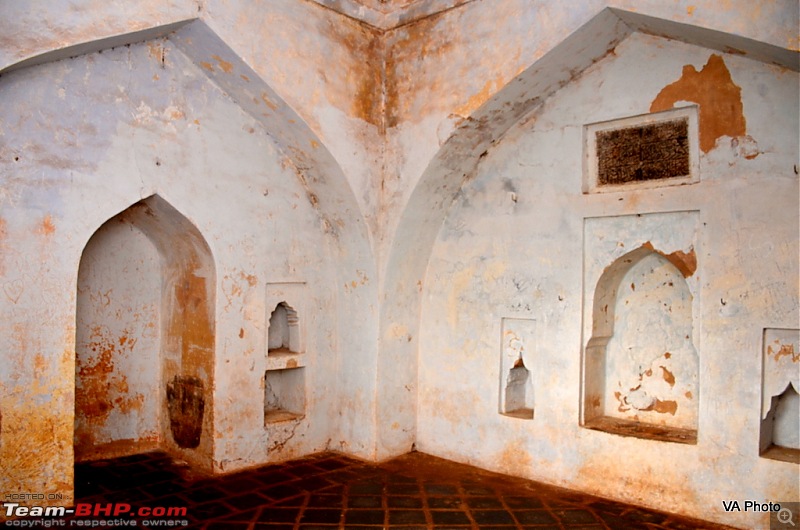 The open balcony looks out to the nearby hill, which appears to have another fort. On careful inspection one doesn’t see any structures inside that fort. At this time, Ram, like the magician pulling out a rabbit from his hat, said with a smile ‘It is a ‘fake’ fort’. I looked at him incredulously.He said ‘the walls are built along the top of the hill – but do not rise higher than the hill itself. It is meant to misguide the enemy approaching from that direction into scaling that hill instead of this. Called ‘pavangad’ – apparently this ruse worked at one point of time.  Sajjakothi is a handsome structure, with plasterwork from the times of Bijapuri kingdom still in place – perhaps redone a few times – double peacock motifs are all over - redolent of the interiors at Seven tombs, Hyderabad.  As a video speaks louder than a thousand pictures, here's a short one I made to show you the interior as well as the view from the top floor. Through this trip, it had noticed repeatedly how much the local population of Maharashtra is engaged in visiting places of historical and cultural importance. Sure, it does happen in other states too, but apart from Tamil people, Maharashtrians seem very proud of their culture. Getting a better understanding of their own culture seems to assume almost ritual proportions. An example was at Sajja kothi, this elderly couple was scrambling to the top – 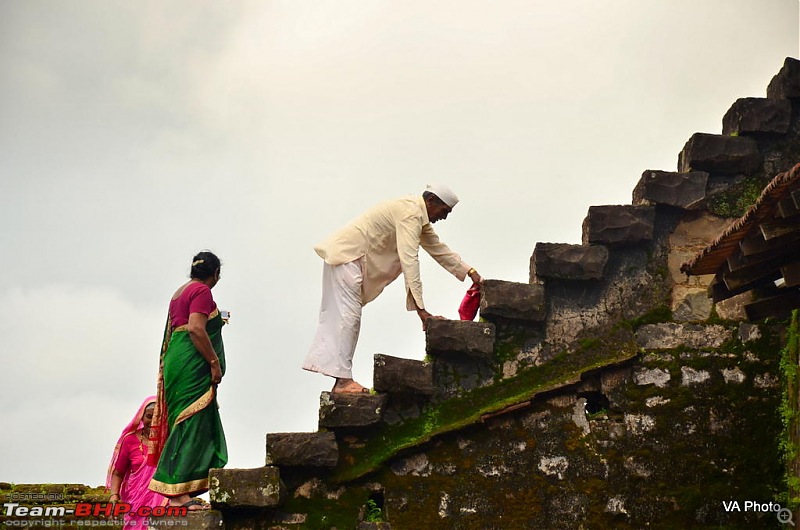 By the time we got done from Sajja, my head was hurting due to the humidity and rising heat. I wanted to get to the point from where to board the bus for Ratnagiri. Ram insisted that we stop at just one more point. This was “Nehru udyaan” – a garden in the general inhabited part of the fort. While it wasn’t particularly well laid, the climatic conditions were propitious for stupendous growth of all flora - many of whom grew disturbingly close to each other, forming hybrids, cross dressers and genetically modified beings straight outta Jurassic world. 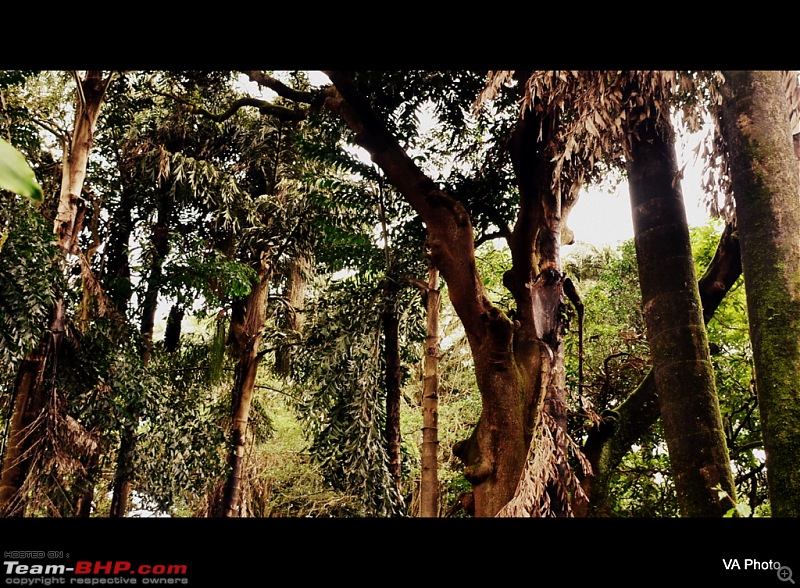 An example was this very large ficus tree in the center – it had developed a composite stem over the decades, perhaps centuries and was large enough for a little toy train to run around it! [Toy trains can't cut down anyone, I reminded myself and breathed a bit better]  (short video below) The garden must have been a hit with the young - maybe they learnt about the environment on a field trip? Or maybe they were star crossed lovers? Reeling from this green shock I give you this murderous haiku- In this garden was seen / Moss so green/ Love so deep (it’s etched) 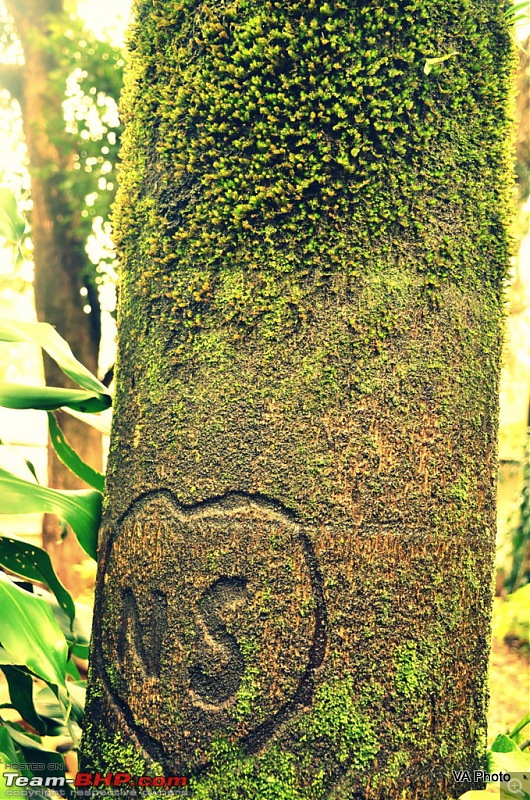 And then of course we had to backtrack just a bit to visit "just one more" spot - it turned out to be a school close by. The school was unusual – the map showed India to be divided between just nine states, a stretch even for me, who loves simplifying everything. 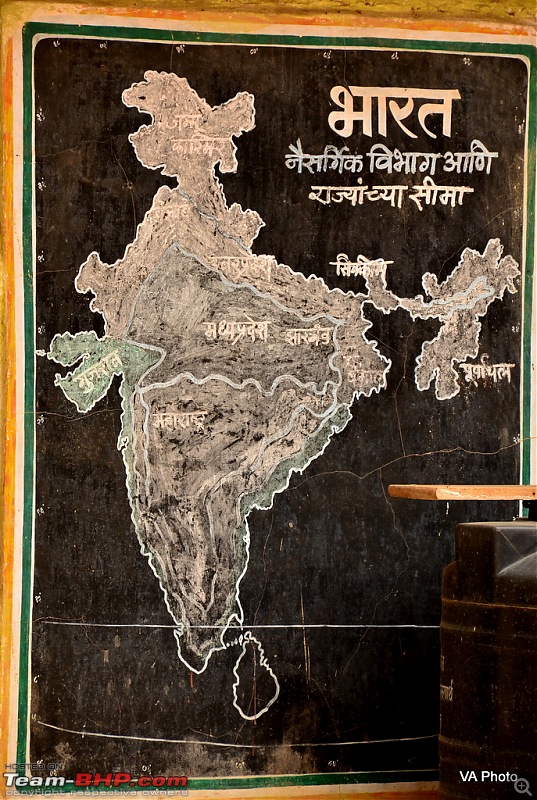 When I asked Ramchandra why he brought me here, he said, "Because it’s old". But he didn’t remember the name of the building or how old it was.  Google later told me that this building was Tarabai Palace (!) – this royal residence belonged to the second most famous resident of this fort – Shivaji’s daughter in law. Tarabai’s place in Kolhapur's history is important as she was the founder queen of Kolhapur regency – the breakaway faction and state within the Maratha confederacy. The palace is in remarkably good state of preservation for its age (approximately 300 plus years) and has been renovated regularly. 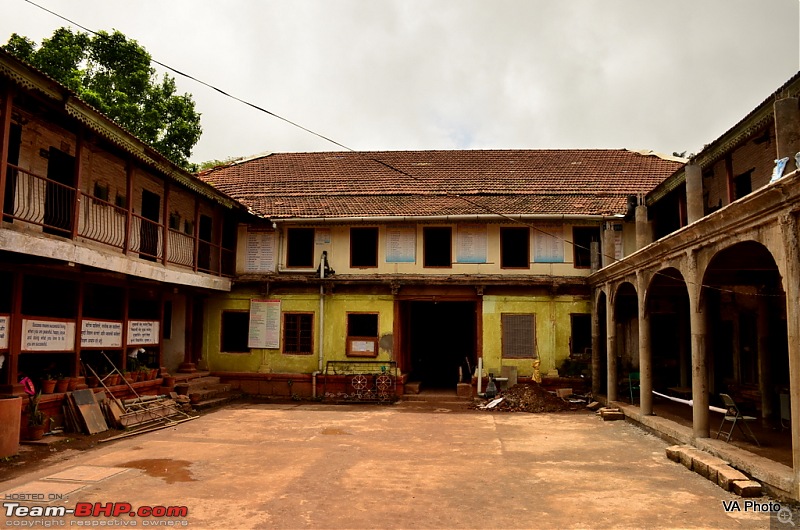 This gave the man who never lied an opportunity to show me just one more spot. He signaled with his hand that I should follow him and so we walked over to a largish clearing besides the school. It was surprisingly, empty and the area was enclosed behind these walls (see below).  This had me a tad worried – I had barely gotten out of a Ramsay brothers’ horror flick and now this. A desolate spot, in a monsoonal land where no one comes looking and organic matter decomposes quickly. Where was I being led? Queasy feeling further deepened when he pointed towards a side of the clearing where the earth rose dozens of feet above, vertically and was held together by stems and roots of tall trees. 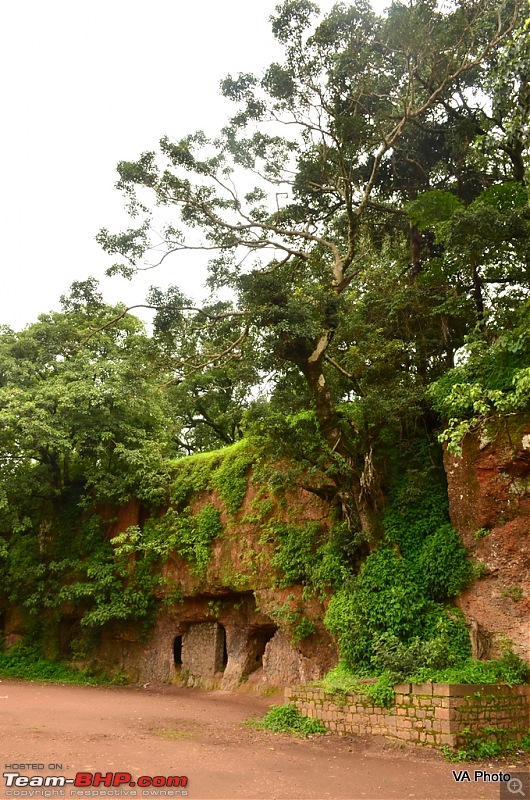 And then he pointed towards these, deep caves in the walls and proceeded to get behind one of the stone curtain walls. That was the last straw – I couldn’t follow blindly any longer and asked loudly ‘’what is this? Why are we here?”  This raised volume startled him a bit and he started grinning sheepishly. He came out from behind the wall and said ‘’oh just to show you. These are called parashar caves. It is said that rishi parashar paid penance sitting inside these caves. Why don’t you come inside and see?” [Yeah right, you should have pushed me down the bastion while you had a chance, mister]. “So what are these new walls for”, I demanded, convinced that there were skeletons behind. “To support the cave. They are quite fragile” and then to prove his point, he ‘’keyed’’ the wall a bit. Rubble fell down into his other hand. [Would've been an easy burial, then]  He went on to say that it is this area where there used to be and still are, a lot of snakes. It gives the fort its name – Pannagalay = place where snakes live [this later changed to panhala]. "You mean to say, there are snakes here too?"  "Haan hai na sahib. Aap dekhenge? Dhoondhoon?" (Of course there are sahib, you'd like to see? should I try to find one?). Clearly this man's idea of fun was different from mine. I pressed him a bit that we should leave as early as possible and he relented. At long last, we drove out of the fort. Last edited by vaibhav_a_a : 24th December 2015 at 11:17. |
| |  (4)
Thanks (4)
Thanks
 |
| The following 4 BHPians Thank vaibhav_a_a for this useful post: | luvDriving, Mahesh Prasad, mallumowgli, raghuvir |
| | #26 |
| BHPian | Re: A Monsoon Solo: Kolhapur, Ganpatipule, Ratnagiri & beyond The choice of vocabulary, the attention or rather passion to detail and history, the way you write : you are an inspiration . A dull boring workday when everyone's holidaying around turned out to be an exciting one. I had to google up words to see what their meaning was  Whenever I wanted to take snaps, I shy away thinking what the people in the frame would think. How do you manage to take them? Last edited by rav11stars : 25th December 2015 at 11:40. Reason: grammar |
| |  ()
Thanks ()
Thanks
 |
| |
| | #27 |
| BHPian Join Date: Feb 2007 Location: Delhi / Jaipur
Posts: 112
Thanked: 264 Times
| Re: A Monsoon Solo: Kolhapur, Ganpatipule, Ratnagiri & beyond Thanks so much rav11stars for the encouraging words. Re : people photos - it's a bit of practice over the years. I typically make eye contact, smile a bit and once a tacit understanding is achieved, click. If no understanding is achieved then wait till they look the other way... |
| |  (1)
Thanks (1)
Thanks
 |
| The following BHPian Thanks vaibhav_a_a for this useful post: | rav11stars |
| | #28 |
| BHPian Join Date: Feb 2007 Location: Delhi / Jaipur
Posts: 112
Thanked: 264 Times
| Thundering down the Mango Pass We descended the hill atop which the fort stands and I found myself sitting at a bus stop at a quarter to three in the afternoon. Joining me in this arduous wait were about a dozen villagers, dressed in varied Maharashtrian rural clothes. I found this gentleman’s headgear particularly interesting (even as some conversation is seen in the background) –  Having deposited me here, Ram insisted that I ‘’tip’’ him 100 rupees over and above what I was due to pay him for the driving for his “excellent guiding’’ services. A little worse for the wear, I paid up.I was quite hungry by then and had a headache, so hoped to get a cup of tea from the shop built inside the bus stop – it promised treats myriad. Turned out these names painted on the wall were mere election promises. “Excellent guide”, ever hospitable, brought me a Vada Pao from a pushcart near the stop but no tea. As a few buses stopped and then went past, and everyone except me, guide and the gentleman below left the stop.  I got a bit worried if I will get to Ganapatipule that day at all. I was in no mood to stay back in Ratnagiri for the night as I had to necessarily spend the last day in Ratnagiri in order to board the train to Bombay on the last day of this five day trip. This worrying proved useless, and in a few minutes, needless as a bus arrived. Ram flagged it down for me. I huddled on-board, my heavy-ish bag helped by the conductor and before I could sit down, the bus started rolling. The bus was a pleasant surprise, it was a deluxe bus, practically empty with good seats though not air conditioned.  The pleasant surprise lasted only a minute as I realized that not only had I forgotten the umbrella I bought just the previous day in the auto, the man who never lied also conveniently pocketed the change from Rs 100 given to purchase vada pao. Facepalm. Our bus was soon passing through splendidly green countryside. Hills so green they looked like oversized golf course obstacles. 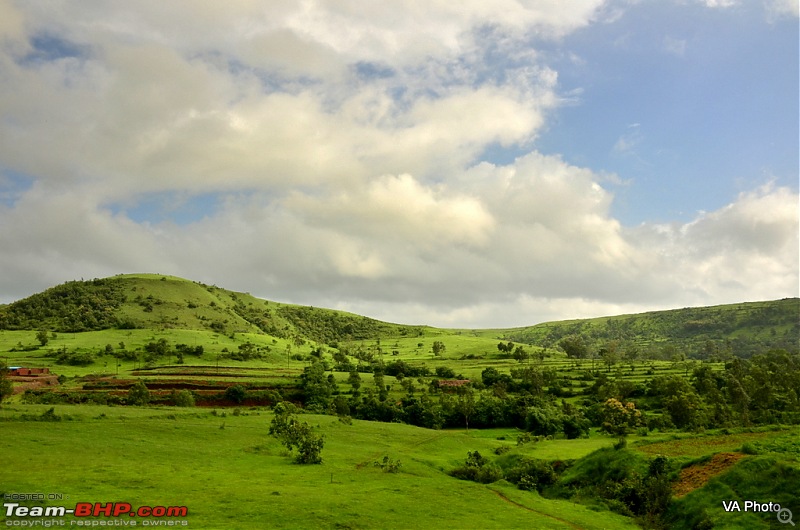 The road was not very curvy but the bus did swerve a fair bit to avoid oncoming traffic (also because the road was narrow and we sometimes drove quite close to the trees on the side)  In just a half hour we stopped at Malkapur bus stand. The Banyan trees opposite the bus stand were fantastically large – how tiny the Jeeps and other vehicles look next to the trees. Here in Rajasthan, the same species grows to no more than half this height, mostly due to malnourishment (a few, I'm sure, just have psychological problems).  It was at Malkapur that I had the opportunity to appreciate the bus that I was riding in – only when I could contrast it with the ordinary buses that were motionless, no doubt awestruck at the sight of a deluxe bus - their doors gaping open! Time stood still for them, while this bus, a deluxe one, was thundering past town and country, eating up mile after mile of the muddy country roads with impunity.  For the next half hour, we cross more green countryside, a table mountain is topped with windmills – India’s push towards renewable energy. I recall the ones on the outskirts of Jaisalmer very vividly – nice to see them here too and more pleasing that no one’s attacking them. We’re perhaps four centuries out of date for that.  Rivers we cross are muddy, brown, carrying filth, sorrow and sins of habitations they pass through.  And then without warning, we were climbing up slowly. I suspected we’d be in the amba ghat region very soon – a series of ghats or passes through the western ghat mountains that line India’s west coast and form an effective barrier between the monsoon winds coming off the Arabian sea and the areas further inland. It is this barrier that causes the clouds to rain down significantly more on the Konkan side – the narrow strip of land that lies between the windward side of the mountains and the sea – than they would anywhere else in peninsular India. The monsoonal clouds do not find a similar barrier till perhaps the Vindhyas and in many cases till the Himalayas. The ghats are named after the goddess Ambabai (mahalaxmi) - the patron deity of Kolhapur or after the marathi word for Mango (amba) depending on who you ask. 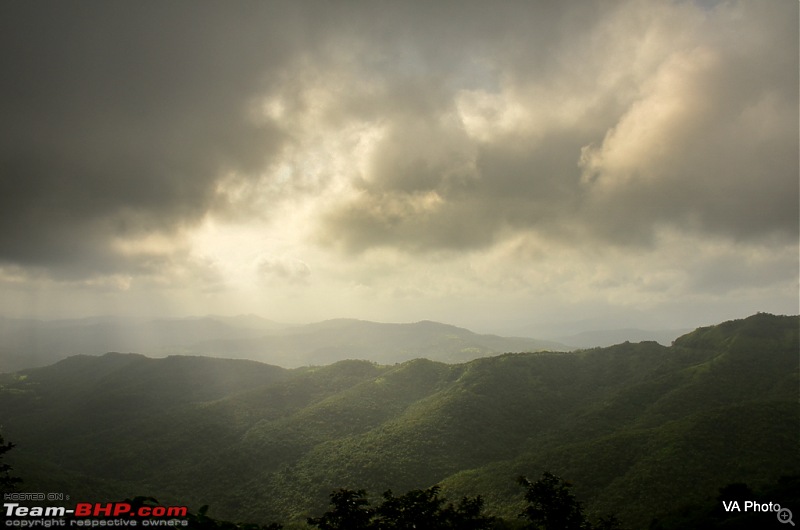 Suffice to say when you see the photos below that it is a limitation of my camera, and my inability to handhold it very still while the state transport bus galloped at approximately 50 kmph on a swerving ghat road. the light was in fact filtering through gaps between the clouds – like drops of gold oozing through a tattered grey quilt.  It was an epic battle – Saranyu attempting to subjugate Prithvi – neither yielding. Sometimes, Prithvi was obstinate against Saranyu’s force. And then Surya would come to Prithvi’s rescue, freeing her from Saranyu’s grasp momentarily.  For a few minutes my eyes would be transfixed at this imaginary clash of the ephemeral and the perpetual and then again I’d be reminded of the reality – that we were about two thousand feet above sea level, and not far from the sea at all. The view speaks for itself.  The show lasted barely fifteen minutes (so fast did the deluxe bus move) and then we slowed down considerably – traffic on the ghats can be high and the rains make it a treacherous place to pass through –accidents are common. Our driver was very experienced and I was thankful for that.  We had descended from the higher points, I could feel that from the lack of galeforce winds and a sudden closing in of the hills around. Still, progress was being made. A few minutes before six, the joyride halted abruptly, so much for the deluxe bus. We were on a road that was perhaps built in a gulch for there was rising earth, about thirty or so feet high held together by the roots of trees and on the other was a small clearing till when a similar though smaller mud wall rose. 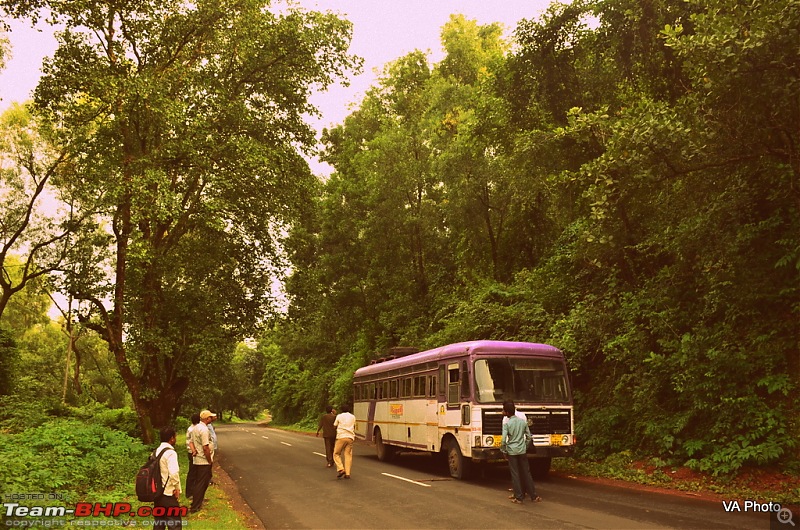 I got down as did the rest of the passengers, I recall we were about a baker’s dozen in number and scattered aimlessly. Turned out the bus got a flat tyre. There was little else to do except what men do in India the moment their roadtrip has come to an abrupt halt in the middle of nowhere – urinate on the side of the road. Once that’s done, some lit up bidis, while I the sole urbanite attempted to get network on my phone to get onto Facebook. When that failed, I got a few photos – One of the flat tyre of my now, colorless, bus -  The second, of men working hard to change the flat -  The tyre change didn't help and we were herded into another bus that stopped by. We covered the remaining 28 kilometres to Ratnagiri in about an hour. At the main bus stand of Ratnagiri, a man at the enquiry window indicated that buses for Ganapatipule leave from parking bay 8 and I should stay close to that. I would have done exactly that but for the fact state transport buses whooshed in with alarming ferocity – threatening to run down any and all of those not in compliance with the imaginary parking bay lines. So I got into the bus as soon as it docked. The condition of the bus cannot be fathomed from the photograph below, some of the seats were coming off their frames.  I reckon the bus left at a half past seven – it is only an hour’s ride to Ganapatipule. There were three other passengers in the bus – an elderly man out front, a young girl and a college going boy. Two got off halfway through. It was quite dark outside – the road is not lit and the headlights of the bus were insufficient. Suddenly the conductor came over and sat down next to me (I was in first row, in the seat behind the driver). I somehow didn’t feel very comfortable with this as he looked at my camera bag more than once. So I started chatting with the college going lad who was sitting across the aisle, in a way bypassing the conductor. It went on for a few kilometres and then, at a stop which was definitely not the last one, that boy also got off. That left only the conductor, driver and me. At this time, they switched off most of the lights in the bus. For a moment, my heart was in my mouth. Thoughts of being outnumbered, in a pitch dark bus, were troubling to say the least. I shouted out (in Hindi) – “When will we reach Ganapatipule?” It was noisy so there was no response. I shouted again – “Why have you switched off the lights?” To which the driver responded, much to my relief, “I need to be able to see better outside.” I made a small video using my phone to show you what it was like. Yes, it really was this dark. Thankfully, none of my fears came true and the bus deposited me safely near the bus stop of Ganpatipule at around half past eight. After some struggle locating a hotel hat would accept a single traveller (the first one turned me down), I got a room, not cheaply, at Hotel Darya Sarang. The two brothers who were manning the front desk suggested that for dinner, I’d better walk down to “Nevaidya” – a thali joint and I did exactly that. The place was clearly run by someone with the dictum “A penny saved is a penny earned” – excess length from the tarp used to cover the ceiling was cut up to cover the tables as well. 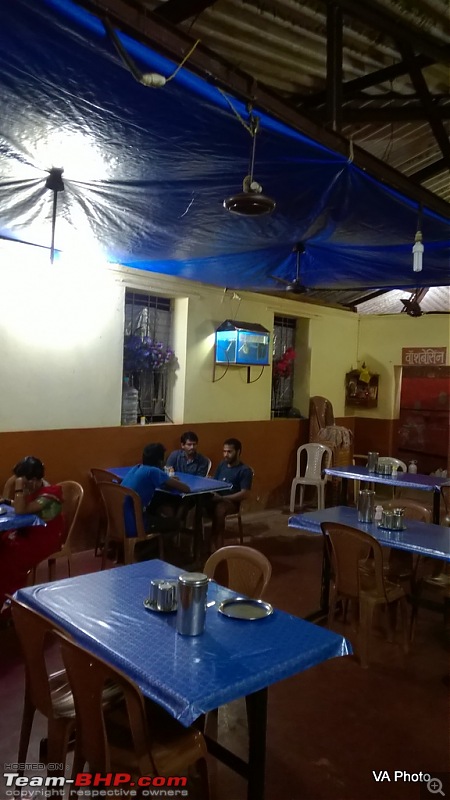 There was a fish with an oversized head in the lone aquarium that refused to be photographed. So here’s a photo of the food instead – a distinctly middling affair. 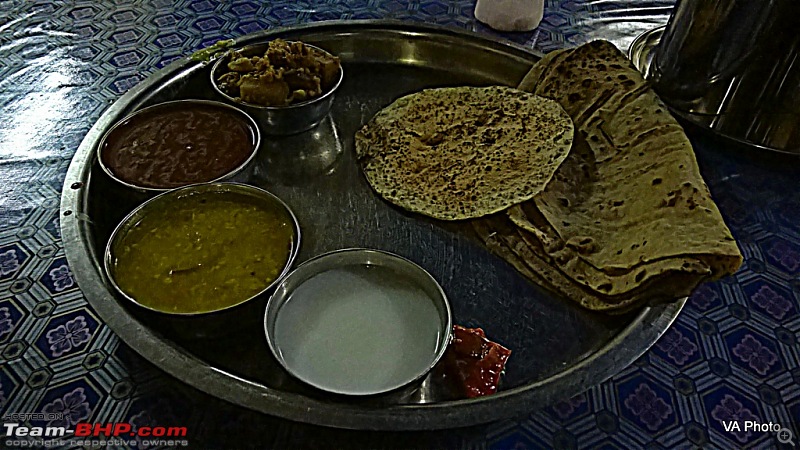 And finally there was a clear list of instructions near the counter  – I offer a few translations –
Walked back to the hotel and drifted into a dreamless sleep with no clear plan for the next day. Last edited by vaibhav_a_a : 26th December 2015 at 15:50. |
| |  (2)
Thanks (2)
Thanks
 |
| The following 2 BHPians Thank vaibhav_a_a for this useful post: | mallumowgli, rav11stars |
| | #29 |
| BHPian Join Date: Feb 2007 Location: Delhi / Jaipur
Posts: 112
Thanked: 264 Times
| Ganapatipule Beach Next morning before seven, I was out and about and on my way to the town’s primary attraction – the Ganesh or Ganapati temple that lends this little town its name as well as raison d'être. Something that hit me was how much humid the air was and a bit warmer too – it felt good that I didn’t have to wear a soft shell jacket though borrowed the umbrella from the front desk. Just as well, halfway to the eponymous temple, heavens opened up and with equal alacrity, the pouring ebbed. It was this interesting pattern of rains that was both reassuring for my remaining adventures as well as something that made it impossible to plan anything with any certainty. I first went down a path paved with red stones and there I was, the famous Ganapatipule beach! I had heard so much about this beach and am pleased to share that it’s not a touristy beach, still. For a mainland beach, it’s still very clean, no plastic and no crowds – at least when I went. Overjoyed, I quickly ran knee deep into the water. It was not the ‘cleer’ water that the malyali man had described, but more somber grey.  A wave came in and I nearly lost my footing. Sufficient to remind me that this was still the Arabian sea, on the west coast and it is known for strong currents and I was to do no such misadventures. Timidly, I went back and looked for a pair of dogs that must have just passed by, but got a couple instead in the far corner of the frame. 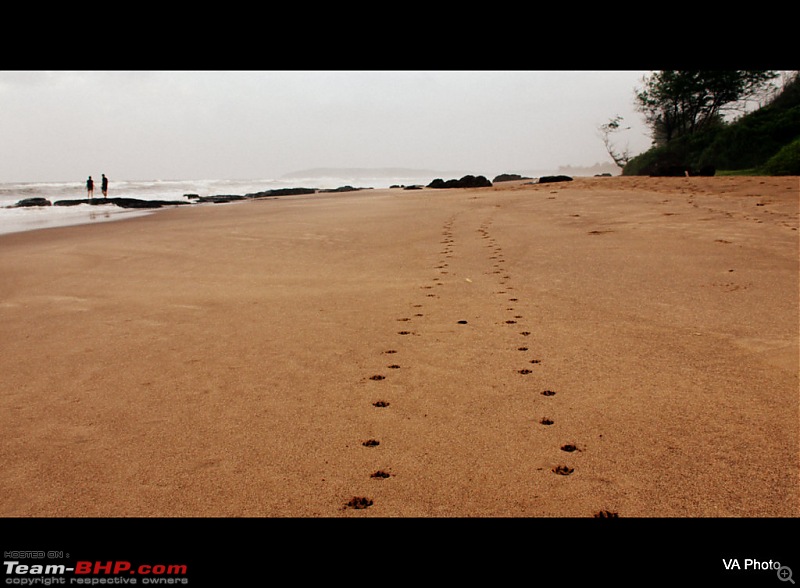 Soon, it was just the couple on this part of the beach and me. They appeared to be on their honeymoon, oblivious to the waves’ lashings and my prying lens. Suddenly a cloud, taller than wider, floated in and perfected the frame.  The access to this part of the beach is largely blocked by the MTDC resort which hogs the best view but it is contiguous with the part which is next to the temple and there’s no barricade of any sort between the two stretches. Goody. The sand was not very fine, but very clean and the abrasive action was exfoliating – my foot sank deeper and deeper and I let it.  Emboldened by the twin bonus of free pedicure and the odd defying survival of the frolicking couple on slippery rocks, I get in deeper as another wave came in. This resulted in a photo and another pseudo haiku- The sun’s not up yet/ It will be even prettier then/ Bet.  Another honeymooning couple arrived and asked me to take a photo of them using their camera. I obliged. Incredibly, they conveniently forgot to thank me once I did what they asked. So I photographed their names etched in the sand and have now thrown them at the mercy of all those who read this thread. She wrote his nickname on the beach expecting it to last no longer than the coming of the next wave, but here on the Ethernet it will never die -  I wondered when the sun would come up from behind the water and the rays falling from the other side reminded me that I was on the wrong coast of India to photograph sunrises. This was the Sunset coast. Duh. As compensation, a Disneyesque cloud of wonderful shape and shade crept up silently -  I soldiered on, getting closer to the town’s main affair, the temple. Here the beach morphed into a family playground. Pilgrims clad from top to bottom frolicked in the waves -  As such, Ganapatipule is no bikini territory (as this photograph captured on the way back to the hotel will affirm). I won’t bore you with a complete translation of a set of instructions (for pilgrims and tourists alike) but a few are not out of line here –
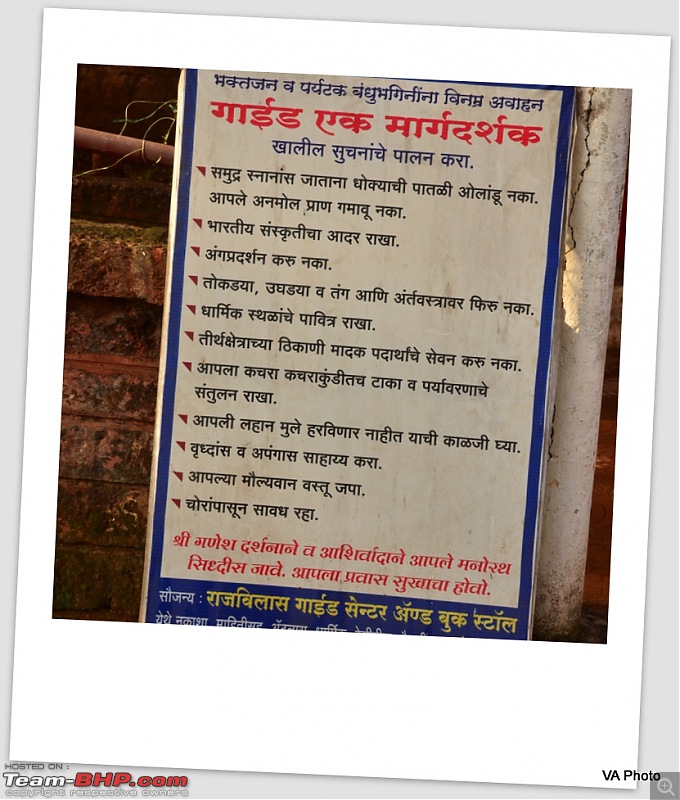 Now, this interpretation of the salient points constituting Indian culture do not seem to include making liquor and selling it as the presence of this cheerfully painted country liquor shop not far from the temple premises affirms.  I have run this train on the siding too long. Back on track, within moments I was at the temple complex, next to the iconic ‘vahana’ (carrier) of Ganesha (or Ganapati, as he’s called in Maharashtra) – a statue as tall as a young child accompanied on either side by a ‘modak’ – a delicacy endemic to the state. Modaks are prepared by steaming rice flour sheets filled with a sauted mixture of jaggery, grated coconut and dry fruit. The method is not dissimilar from that of preparing a dumpling. They are said to be the God’s favourite food. **This mouse’s expression clearly states he’s not to be messed with, at least when it comes to the modak business. 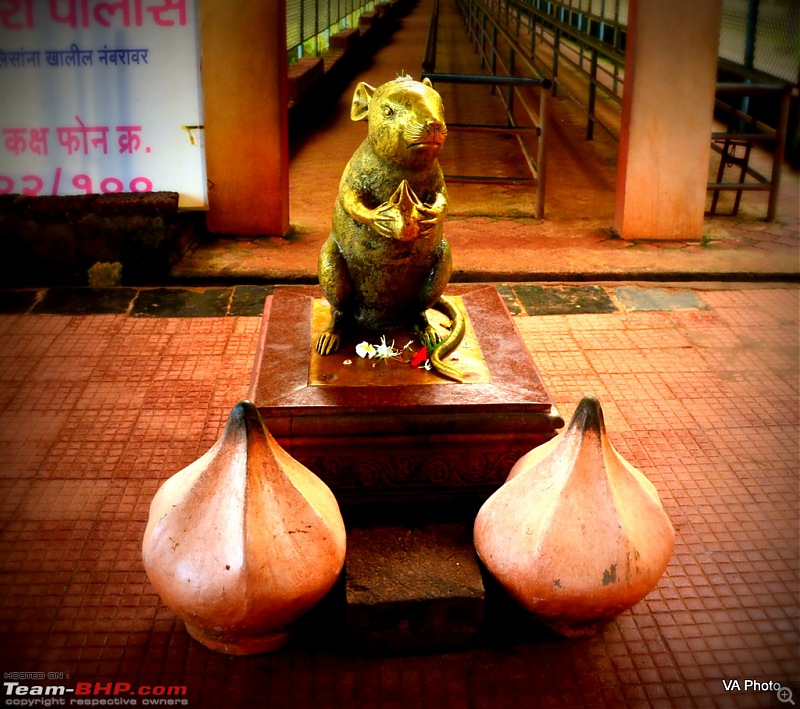 I was momentarily distracted by the sound of thunder. When I had left the beach, it was all clear – as you’d have seen in my photographs earlier in this post. However, clouds rolled in even as I was photographing this Om sign framed by four coconut trees and it was much darker than before. When viewed from under the walkway, the trees seemed to pull the clouds to pour over the Om sign - a Jal arpan (water offering) if you will - a moment approaching an Epiphany for me.  Without any warning, it started pouring so fast, I was genuinely surprised at the intensity. Pitter patter got louder to a stronger waterfall sound over the corrugated steel sheets that cover the walkway. These flower sellers were also awaiting their first buyers of the day and had to wait a bit longer.  The shower was so intense that I wasn’t able to cross about a two foot open to the skies gap in the walkway through which the rain came down – pounding hard and I just waited. Within minutes, the way it had started, it was gone too. Rain doesn’t continue for long on the coast here, it comes in 15 minute bursts tops and then ends – the clouds take their load a bit further inland and repeat the same sequence. It’s a bit like irrigating a very large field – just naturally. Having left my shoes outside, I walked in and was face to face with the first security guard. A bit worried about leaving my camera bag outside I asked if there was a locker to which he smiled such a genial smile that I wondered if ever managed to keep a real miscreant away. He simply waved me on and said, no problem you can take it inside. A nicer man you could not meet. The temple itself is neither ornate nor large. I was in and out the other side so quickly I wondered what the fuss had been all about. The exterior seems to have been renovated and painted freshly. The temple appears, in an endearing sort of way, to be made of plaster of paris and then painted over – on closer inspection it hints of smooth finished terracotta. The temple stands against a rising hill that is circumambulated by the devotees but on this day, there were only a handful and I had the entire place to myself. For this, I shall be eternally grateful to the great Indian monsoon.  The idol of Ganesh here is said to be 400 years old but from the looks of the temple, you could never make that out. On the exterior, many different forms and poses of the elephant headed god are seen – most notable ones are where his physical form is not very well defined, it is a sort of fluidic shape, more symbolic a representation than a hard earthly stamp.  On my way out, I purchased some Prasad from the temple - couple laddoos (sweetmeat) in a neat plastic pack for Rs 15/-. Apparently, nothing’s free in Konkan. Not even the Prasad at this temple of the guardian of the west coast of India – the bountiful Ganapati of Ganapatipule. With the main item off the checklist, I had little else to do except walk back to the hotel looking for a place to have breakfast en route. Some promised much, but a bit later. How much later, they wouldn’t say -  I asked around for ‘modaks’ – Ganesha’s favorite offering – but was turned down, at least in one case, rather gruffly. Another person, suspicious of why have I come to this part of the country all alone, after asking a series of personal questions, explained that modaks take time to prepare and are prepared only on order – a typical minimum quantity is 20. Since I didn’t look like the sort to polish off twenty during a single sitting, the conversation didn't take off. The sights all around did nothing to alleviate my pangs – taller than buildings, these coconut trees were interspersed with arecanut, mango and banana trees, betel leaf vines and other cash crops - a higher density per square inch of soil I have not seen. Food all around, yet so unapproachable.  At a half past eight, I was back to the hotel. Last edited by vaibhav_a_a : 29th December 2015 at 12:05. |
| |  (3)
Thanks (3)
Thanks
 |
| The following 3 BHPians Thank vaibhav_a_a for this useful post: | luvDriving, mallumowgli, rav11stars |
| | #30 |
| BHPian Join Date: Jun 2013 Location: Pune
Posts: 375
Thanked: 847 Times
| Re: A Monsoon Solo: Kolhapur, Ganpatipule, Ratnagiri & beyond Thanks for this wonderful post. You have a very lucid, flowing style of writing which is sheer poetry ! You have captured the essence of the monsoons in Konkan with the lush greenary and the light play by the Sun. Now that you have reached Ganapatipule, I am waiting eagerly for ratnagiri and the beyond. |
| |  (1)
Thanks (1)
Thanks
 |
| The following BHPian Thanks luvDriving for this useful post: | vaibhav_a_a |
 |

